
|
Home DH-Debate 39. Christoffer 1. 41. Erik Menved |
| 1. Introduction | 2. Erik Klipping |
| 3. Margrete Sambiria | 4. Danehof |
| 5. King of Denmark | 6. Sweden |
| 7. Norway | 8. Family |
| 9. Murder of the King | 10. The Outlaws |
| 11. Alternatives | 12. Literature |
King Christoffer 1. died suddenly in Ribe around 1. of June 1259. His minor son, Erik - who was to be bynamed Klipping - was already hailed as king by the kingdom's great men, but not yet crowned because Archbishop Jacob Erlandsen had refused to do so and furthermore forbidden all other bishops from performing this act.
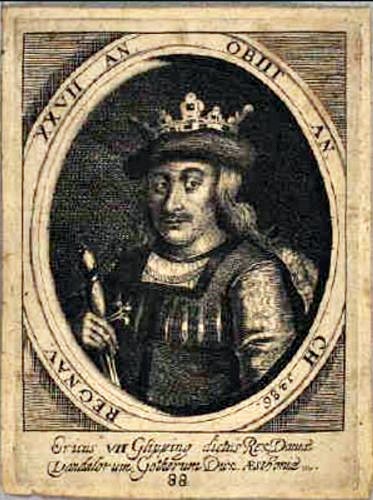
Copper engraving from 1685 depicting Erik Klipping. He ruled Denmark for 27 years from 1259 to 1286. He is also known as Erik Glipping. The nickname alludes to the fact that he degraded the coin. It is highly unlikely that there is portrait likeness. Photo Det Kongelige Bibliotek.
In the years after Christoffer's death, Denmark was a kingdom plagued by many problems. The situation in 1259 was chaotic and difficult.
The archbishop's supporters and allies waged holy war against the monarchy. An experienced army led by Prince Jaromar of Rügen and Erik Abelsen from Slesvig had conquered the island of Bornholm and Copenhagen. Jaromar had then defeated a peasant army at Næstved and was now taking the rest of Sjælland and Scania.
In southern Jutland, the Holstenians, supported by the Abel family, had taken the city of Slesvig and now pushed further north.
In this critical situation, the widowed queen, Margrete Sambiria, was appointed guardian of her and Christoffer's 11-year-old son, Erik.
For seven years she fought like a raging lioness for her son and Denmark with all the means at her disposal, including personal connections and diplomatic and military means - until Erik turned 18 in 1266 and thus of age. Margrete then retired to the royal family's castle in Nykøbing Falster, but remained for many years - as a gray eminence - a powerful agent in Danish politics until her death in December 1282.

|
Denmark's history divided into Royal Dynasties. However, all the kings - except Magnus the Good - come from "Hardegon, son of a certain Sven" , who conquered a large part of Jutland around 917 as narrated by Adam of Bremen in his section on Bishop Hoger. The line of kings and stories about war and peace are the backbone of history - not that stories about culture and ordinary people's living conditions are not important and interesting - but without the line of kings, the history can easily become a kind of relatively unstructured chatting about aspects of Danish history that pedagogically cannot easily be fixed in timed. It gives a good overview to divide the royal line - and thus Danish history - into manageable sections.
The Knytlinge dynasty got its name from a Hardecnudth, probably the son of Sven. He is also called Knud 1. and was with great certainty the father of Gorm the Old, as narrated by Adam of Bremen under Bishop Unni.
Magnus the Good, who became king in 1047, was the son of the Norwegian saint king Olav; his reign constitutes a transitional period to the time of Svend Estridsen and his sons and grandsons.
The rival kings, Svend, Knud and Valdemar, from 1146 to 1157, all descended from Sweyn Estridson; their time forms an interregnum to the time of the Valdemars.
Many historians, probably most, include only Valdemar the Great and his sons Knud the Sixth and Valdemar the Victorious to the Valdemars. But one can not have a patent on such a definition, and it seems appropriate for the author to include their less successful descendants - including Erik Ploughpenning, Abel and Christoffer 1. - until Christoffer 2. who was the last king before Denmark's kingless time from 1340.
Valdemar Atterdag was not king of the Kalmar Union, but his grandson, Olaf was, and his daughter Margrete 1. became queen of the Scandinavian Union. One can say - with a little good will - that Valdemar Atterdag recreated Denmark and thus the possibility of the Kalmar Union with Norway and Sweden.
The first Oldenburg kings were only Union kings for short periods.
The Civil War, The Count's Feud, 1534-36 was a decisive turning point in Denmark's history. As a consequence of the Lutheran Reformation, which took place at the same time, the kings confiscated the third of Denmark's agricultural land that belonged to the church. This fabulous wealth made it possible for them to subdue Denmark's old nobility and after some time to establish the autocracy, which became one of the most important reasons for Denmark's historic deroute. In 1848, a democratic constitution was introduced without civil war or other violent events.
The Oldenburg royal family died out in 1863 with the childless Frederik 7. The throne was then given to Christian 9. of Glücksborg.
Erik Klipping's reign is known for the annual meetings in Nyborg, which was later named Danehof, that however, already took place under his father, Christoffer 1.
As a precondition for their support, the chieftains forced the king to sign a "hand-binding", which limited his power. According to the treaty - which can be seen as a kind of early constitution - the king should regularly, perhaps once a year, convene the "best men of the kingdom" to the Danehof and rule the country with them.
The custom of holding such meetings in Nyborg continued until the time of Valdemar Atterdag and Erik of Pomerania, when the function of the Danehof was replaced by a permanent royal council, which functioned until Frederik 3. abolished it with the autocracy in 1660.
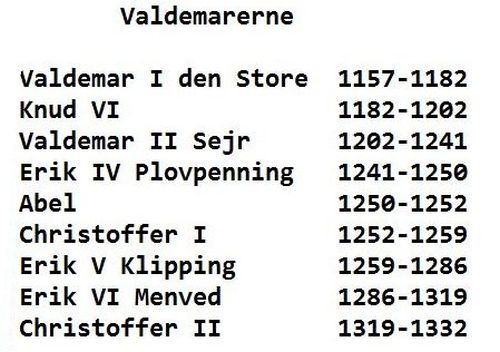
The Valdemars. It is common simply to attribute Valdemar the Great, Canute the Sixth and Valdemar the Victorious to the Valdemars. But thereby their less successful descendants become pedagogically homeless, even though they are direct descendants after the first and more famous Valdemars, and they are not separated from these by any natural period of transformation. Therefore, I would suggest that the whole group until the kingless time to be called the Valdemars.
Erik Ploughpenning, Abel and Christoffer were sons of Valdemar the Victorious and they succeeded each other as kings. Abel had his brother, Erik, killed and his body immersed in the fjord of Slien. However, 24 knights swore he was innocent and therefore he could still be elected king. However, only a short time later, he was killed in battle during a campaign against Friesland, and then his younger brother, Christoffer, was chosen as his successor as king, and the deceased Abel's eldest son was thereby bypassed. In the following decades, this led to a long-standing rivalry between the descendants of Abel and Christoffer, respectively, and contributed to the historical division of the original Denmark into the kingdom and the duchies.
Only 11 years old, Christoffer's son, Erik, who was later bynamed Klipping, became king with his dynamic mother, Margrete Sambiria, as guardian. The chieftains limited his power with a "handbinding" contract at Nyborg Castle, which among other things decided that the meeting of king and the best men, which was later called the Danehof, should be the country's highest court. In addition, it was ruled that the Royal Court could only deal with cases that had previously been presented to another court and that it could only impose standard fines. Erik Klipping was killed in Finderup Lade near Viborg with 56 stab wounds - this murder is still one of the great mysteries in Danish history. His son Erik Menved tried to create goodwill and increased influence in northern Germany by holding some magnificent - but most likely expensive - knight tournaments. He was succeeded by his brother, Christoffer 2. who had to take over his brother's large debts, while at the same time the possibilities of increasing the royal revenue by increased taxes were blocked by a handbinding contract. When he died in 1332, no new Danish king was elected, and for a period the country was without a king.
Erik Klipping was murdered in Finderup Barn Sct. Cecilie night on 22. of November 1286, which is one of the greatest mysteries in Danish history. At the Danehof in Nyborg in 1287, Count Jakob of Halland, Marsk Stig Andersen and seven others were convicted of the murder by a board of 3 times 12 men - almost unanimously - which is quite convincing.
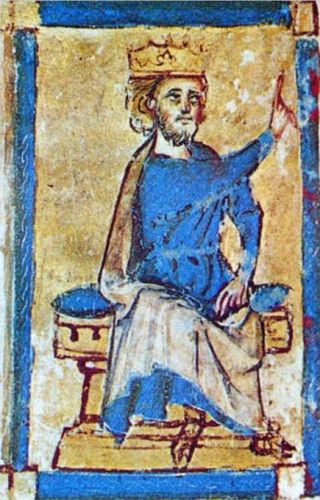
Erik Klipping in handwriting from Tallinn from 1282 - that means it is drawn during his lifetime. Although the artist may not have seen the king himself, he may have heard from others how he looked like. He may very well have been a red-blond athletic type, as shown in this drawing. Photo Krol Danii Eryk Glipping Miniatura z 1282 r. Oryginal znajduje sie w Tallinie - Wikipedia.
Erik Klipping was the son of Christoffer 1. and his queen Margrete Sambiria. He was born in the year 1249, which was the year before the murder of Erik Ploughpenning and just one year after Margrete and Christoffer's wedding in 1248.
The birthplace is most likely the castle in Nykøbing Falster, where Christoffer resided as prince of the islands Lolland and Falster, which area his father, Valdemar the Victorious, had handed over to him as a princely fief in 1232.
Erik and his mother, Margrete Sambiria, were taken prisoner by the Holstenians after the battle of Lohede 1261 and he then spent well three years in Brandenburg as a hostage, which was to guarantee against revenge. He thus resided in a German principality for three important years during his upbringing and was probably here influenced by German culture and values.
In 1264 he returned to Denmark, soon came of age and ascended as reigning king in 1266.
I will make an attempt to describe his personality as we can deduce it from historical information and logical considerations.
Especially folk songs, which are estimated to have been created long after Erik's lifetime, revolve around the subject of the king, who seduces and rapes his men's wives. The historical sources from the immediate aftermath - but still 50-100 years later - also contain also some condemnations of Erik's "unchaste" life:
Jutland Chronicle (about 1350) writes: "Full of vices, as he was, he used violence against the wives of the chieftains."
The Lübeck Annales (about 1323) takes, however, the reservation "reportedly": "Erik, king of the Danes, was killed in his bed the night of Sct. Cecilie, reportedly because of his unchaste life."

The last remaining ruin of Erik Klipping's birthplace, Nykøbing Castle, in front of Nordisk Film Cinemas in Nykøbing Falster. Photo Toxophilus - Wikipedia.
Ryd Monestary Chronicle for the year 1259 is very critical of King Erik - but not for his sexual excesses: "Then Erik Christoffersen became lord of all Denmark, and he did many evil and sinful deeds. He robbed the churches of their tithes. If somebody was exposed to wrongs, he did not pay compensation. The monasteries that his ancestors built, he impoverished and forced with his own guesting and with his horses and dogs."
The content of the oldest folk songs about the murder in Finderup Barn is first and foremost political. They typically talk about "there are so many in Denmark that all want to be masters" and similar themes. Only in songs that are estimated to have been created 50 to 100 years later than the assassination of the king, the motif of seduction appears and describes that the king seduced Marsk Stig's wife while the marsk was at war in Sweden.
First Christiern Pedersen (about 1550) and Arild Huitfeldt (aout 1600) bring real juicy descriptions of King Erik's unchaste life. But apart from these, there is no solid historical evidence of Erik's immoral life. There are no named left hand wives or mistresses and no sons or daughters outside of marriage, as is the case with so many other kings.
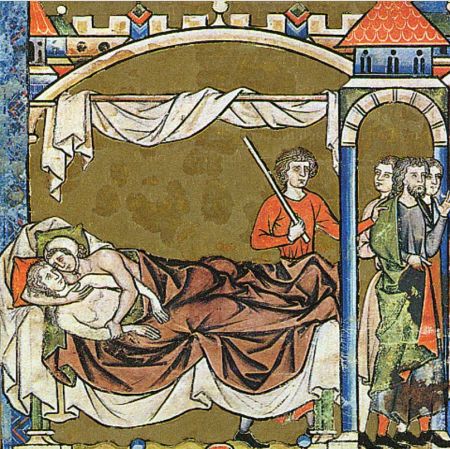
Amnon rapes Tamar after the servants are asked to leave the room in the Morgan Bible reportedly from 1250. 2. Samuel 13: 1. Photo Wikimedia.
The folk songs claim that King Erik should have offended Marsk Stig's wife, Ingeborg, while the marsk was at war in Sweden, and this was the reason why he killed King Erik. But if such a violation had really taken place, it would have happened ten years before the fateful Sct. Cecilie night, and meanwhile Ingeborg had died and the marsk had married someone else.
Therefore, the accounts of Erik's unchaste life manifested by his seductions of the wives of the noblemen are probably not completely true.
But no smoke without fire. They probably represent that he was handsome guy, cheerful and outgoing - and this together with his high rank in society aroused women's feelings - without, however, it generally led to physical relations.
Men rival about women's love. This alone - that a husband feels that his wife is attracted and fascinated by another man - is enough to arouse his jealousy and reluctance towards the object of the woman's fascination. Yes, actually there is no need to even a woman to be involved, only this - that a man is beautiful and charming and thus has the potential to attract women - will often arouse other men's unconscious unwillingness and enmity.
The Swiss psychiatrist Carl Jung described that the attitudes, thoughts and decisions of extraverts - that is outgoing people - are not only influenced by, but directly determined by the dominant public attitudes: "Accordingly, the extravert's philosophy of life and his ethics are as a rule of a highly collective nature with a strong streak of altruism, and his conscience is in large measure dependent on public opinion - His religious convictions are determined, so to speak, by majority vote." Which explains why modern actors, singers and the like - who are always very extraverted people - are particularly ardent supporters of the prevailing climate religion, multiculturalism and LGBT enthusiasm.
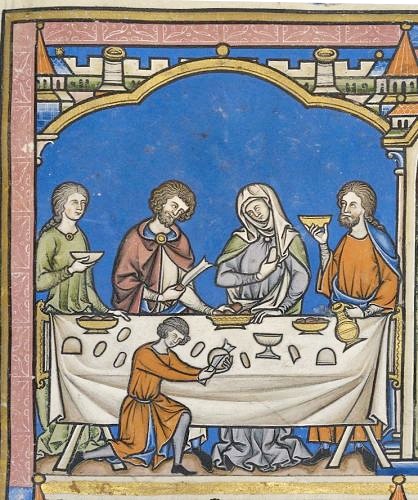
Illustration of a dinner in Maciejowski Bible also called the Crusader Bible or the Morgan Bible reportedly from 1250. Photo Wikimedia.
Therefore, if it is true - as I believe - that Erik was a cheerful and outgoing person - then he can not at the same time have been a fighter type who, against all odds, fought for Denmark surrounded by numerous enemies - like his mother. On the contrary, he must have wanted to be accepted by the others and wanted to acquire the generally prevailing attitudes.
The rumors about his unchaste life should rather be attributed to the fact that quite shortly after his mother's death in 1282 he returned Valdemar the Victoriously's princely fiefs to this king's descendants and possibly then indulged in a more hedonistic lifestyle with hunting, knight-tournaments and parties. He may have given back the princely fiefs for rational reasons, but objectively he threw away all that his father and later the widowed queen had achieved in terms of turning back the fiefs into natural parts of Denmark.
Margrete Sambiria and the young Erik were really surrounded by numerous enemies and political opponents who loved to hate them. In a way, they were in the same situation that US President Donald Trump has been in recent times.
Although Erik and his mother simply sought to make amends for Valdemar the Victorious's overly generous distribution of land to his many sons - a circumstance that threatened Denmark's existence - the other branches of the royal family showed no mercy and probably stamped this policy as pure "injustice" - often supported by a majority in the Danehof assembly, who also zealously advocated "justice".
But Erik Klipping was no Donald, and he apparently had a hard time confronting so much resistance and overt hatred. Widow Queen Margrethe looked more like a medieval Trump.
The Abel family claimed "Jutland" (which was Southern Jutland), and they made no secret that they considered the Christoffer family to be throne robbers, and themselves as the right royal family. Valdemar the Victorious' grandson, Count Jacob, claimed North Halland, another grandson, Erik Knudsen, demanded Blekinge.
Led by Archbishop Jacob Erlandsen and his fanatical followers, large sections of the church demanded increased rights and property, and basically they wanted the king removed by any available means as they had removed Erik's father, King Christoffer, in Ribe.
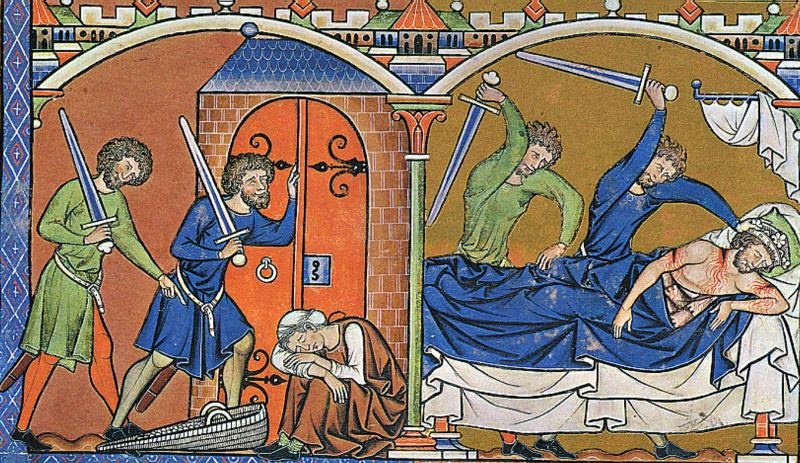
The assassination of King Ishboshet in the Morgan Bible reportedly from 1250. Two captains from the guard in the Ishbosheth camp sneak into the king's house and kill him while he sleeps. Samuel's Book. Photo Maciejowski Bible Wikimedia.
Most - but not all - of the rich and powerful Hvide lineage most likely still nurtured an irreconcilable aversion to the kings, probably because they wanted their own candidate elected king.
The kings of Norway and Sweden were married to daughters of Erik Ploughpenning and demanded their dowry to be handed over in the form of Danish agricultural land and other rights.
The principalities and cities of northern Germany had not forgotten that Denmark under Valdemar the Great and Canute the Sixth only a hundred years before had been a great power - compared to the many principalities - which had been able to conquer the entire area of the Slaws north of The Elbe and Hamburg and Holsten. Supported by other principalities, Holsten demanded "justice" for the Abel family, thereby splitting and weakening Denmark by separating the rich and fertile region, Southern Jutland, from the kingdom, and linking this region to Holsten, which in turn collaborated with other German principalities.
An outgoing person that we may believe King Erik was must have had a very hard time confronting such a hostile and toxic environment.
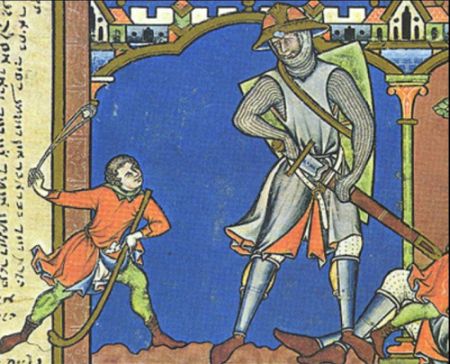
David and Goliath in the Morgan Bible reportly from 1250. Photo Wikimedia.
In connection with the foundation of the Land Peace League in 1283-1284 in northern Germany, Erik made a fundamental change of course in Danish politics - just a year after the death of his mother Margrete Sambiria.
Erik and the widowed queen's loyal support, drost - a kind of chancellor - Peder Nielsen Hoseøl, was replaced by Valdemar the Victorious's grandson Erik Knudsen. Furthermore, "justice" was done to the fullest, so that it was understood that all claims against the throne for the fiefs and settlement of inheritance and dowry for Erik Ploughpenning's daughters were met - and obviously - the royal income was correspondingly reduced.
Such a political reversal may have been objectively necessary to counteract a potential aggression by the Land Peace Alliance, which was fundamentally a military alliance. But the political U-turn may at the same time have been a realization of Erik's longing to have good relationship with everyone. As an outgoing personality type, he had a hard time perceiving himself as a man in confrontation with numerous enemies.
Denmark's accession treaty to the Land Peace Alliance tells us something about Erik's visions of peace: "Erik, by the grace of God the King of Danes and Slaws, to all who see this letter, greetings with God. You must know that we in consideration of that where peace and unity are growing there promotes all goods, for this reason for the good of peace and the good of the interests of the state."
However, in the cardinals' final report on the case brought by Archbishop Jens Grand at the papal court against king Erik Menved in 1296, the cardinals do not have much respect for Erik Klipping: "This archbishop's (Jens Grand's) relatives - namely, count Jacob, Marsk Stig, Peder Jacobsen, Rane Jonsen and several others of their families and relatives, they were noble of lineage, but unlucky and unfortunate in deed. The king made them rich above all the kingdom's loyal supporters, so that he alone reserved for himself the name of king." It seems as they thought that he had shied away from all royal responsibilities to enjoy the benefits of being king only.
As mentioned above, widow queen Margrete Sambiria was installed as guardian of 11-year-old Erik at Christoffer's death in Ribe in the summer 1259.
She had to face the harsh reality, which was that the peasants' army had suffered a crushing defeat against Jaromar's crusaders in the Battle of Næstved, the Holstenians and the Abel family were on the rise in southern Jutland and the imprisoned Archbishop Erlandsen's supporters declared an interdict all over the country.
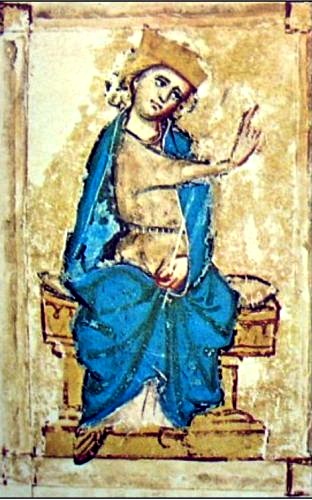
Margrete Sambiria in handwriting from Tallinn from 1282 - that is, it is made in her lifetime. After Erik was declared of age, she was named "Lady of Estonia". She was - as far as is known - never personally in Estonia. But the artist must have heard of her and of what she looked like. Here she also bears some resemblance to the sculpture on her grave in Bad Doberan which makes portrait likeness likely.
The byname Sambiria comes from that she was the daughter of the East Pomeranian Prince
Sambor. Her other bykname "Jumping Horse" allegedly came from her riding a horse to death during the battle of Lohede. In the folk songs, she is called Black Grete because of her dark hair.
Photo Krolowa Malgorzata Sambiria afT Miniatura z 1282 r. Oryginal znajduje sie w Tallinie - Wikipedia.
She stabilized the situation by buying peace, giving concessions to all sides.
She had the imprisoned Jacob Erlandsen released from his captivity at Hagenskov near Assens and thereby she satisfied Prince Jaromar and his German allies - at least the historical sources do not tell further about his army on Sjælland. He has probably surrendered all conquests to the now released archbishop and sent his expensive soldiers back to Germany. Moreover, releasing the archbishop was probably a precondition for negotiations with the pope.
She satisfied the Holstenians by promising to install Erik Abelsen as Duke of "Jutland" (meaning Southern Jutland), which duchy had otherwise been revoked by the king after the former duke's death.
On Christmas Day 1259, the widowed queen had her son, Erik, crowned king in Viborg Cathedral by Bishop Niels. But the irreconcilable Archbishop Erlandsen regarded his recent release as a great victory and followed it up by immediately - without exceptions - banning all bishops and other clergy who had attended the ceremony.
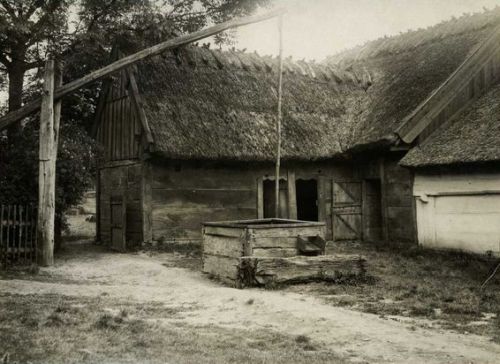
Næsgården from Gønge Herred in Scania at the Open Air Museum near Lyngby gives a pretty good picture how medieval wooden buildings looked like. Photo Nationalmuseets samlinger online.
On the whole, neither the captivity in Hagenskov nor the release had made Archbishop Jacob Erlandsen more cooperative.
The Queen and the Danish government therefore chose in 1260-1261 to send a complaint to the Pope about Jacob Erlandsen as archbishop. The Danish envoys to the Papal Court brought a list of 21 complaints, which included:
"1. Although he has sworn allegiance to the king, he has in Lund Church and elsewhere conspired with the king's enemies, Jærmer and the counts of Holsten, and helped them against the king."
"2. Jærmer and the archbishop's brother Anders, together with the same archbishop's men, have killed about 200 of the king's men on the island of Bornholm, taxed the others hard and abolished the king's castle there on the island; and he has confessed that these things were done at his commandment."
"3. Although he had paid allegiance to King Erik, son of the late King Kristoffer, and sworn to serve him faithfully, he has raised up against him and refused to crown him when he was asked to do it, though he had appointed a day for this; yes he has stepped in the way of his coronation and has banned those who crowned him even after appeal was delivered."
"9. When he was summoned to Slesvig to defend the kingdom, he did not meet with armed men, as was his duty, and left again without permission."
"10. When he was summoned to Stegeborg to defend the kingdom, he did not come."
"14. He protcts the king's enemies and pursues his friends.."
"15. He has in a meeting for the whole nation in Roskilde declared that those, who together with the bishop of Roskilde, had killed the men of Sjælland (in the battle of Næstved) , had done right, and for them there should be prayers, but on no way for those of Sjælland - although these, however, have fallen for their land and legal rights - and that those who were banned were not allowed to receive ecclesiastical burial."
"21. He has put the king to hatred at the Roman court by giving his word that he was not a true believer, but a heretic. There is a letter from him about this. But separately, his breach of fidelity and fraud must be dealt with."
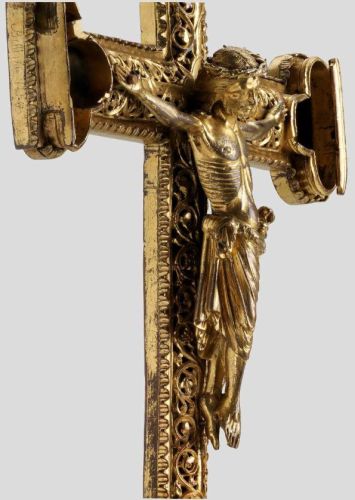
Crucifix in gilded copper in Bellinge church south of Odense from around 1250. Christ is nailed to a very finely processed perforated Cross. The empty fields at the tip of the arms must have contained crystals. It is made in England or made in English style. Photo Nationalmuseet.
Erik Ploughpenning had four daughters, who after his death were raised at the court. By the coronation of Erik Klipping in 1259, they approached the age of marriage.
Widow Queen Margrethe must have been quite uneasy about the prospect of having to marry away as many as four princesses in addition to her own two daughters, Mechtilde and Richiza. Because they all had to have dowry and inheritance in the form of land and estates in Denmark, which after years would come into the hands of foreign princes - and thereby reduce the royal income.
In King Christoffer's last year of life, the eldest, Sofie Eriksdaughter - 18 years old - had been promised to the young king Valdemar Birgerssen of Sweden. Around 1260 she traveled to her wedding in Sweden - in that connection she was promised the towns of Malmö and Trelleborg in dowry - which illustrates the large expenses that were connected to marry off a princess.
Sofie got a very eventful life in Sweden. Swedish sources describe her as a beautiful, quick-witted, temperamental and dominant woman with a sharp tongue, and there are many quotes with her sharp remarks.
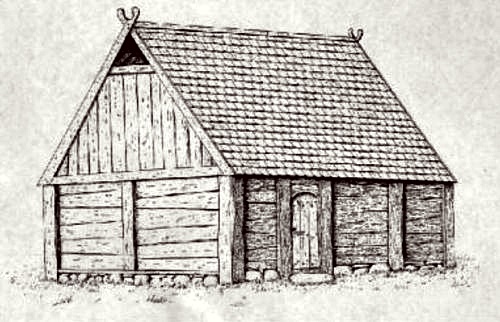
Graphically reconstructed medieval house from the 12-1300's based on excavations in Skrillinge on the outskirts of Middelfart. Photo Odense Bys Museer.
Perhaps in 1260-1261 Christoffer 1's friend, the Norwegian king, Håkon Håkonsson, proposed on behalf of his son to the second eldest daughter, Ingeborg Eriksdaughter, and Margrete perhaps answered yes or gave a delaying answer. However, probably due to problems with the Duke of "Jutland" (that is Southern Jutland), she had the seventeen-year-old Ingeborg placed in a monastery near Horsens, it is said.
But it did not take the courage from the Norwegians. King Håkon sent seven ships under the command of Bishop Håkon of Oslo directly to the monastery, and Ingeborg, who was not interested in a life as a nun, did not hesitate to pack her things and hurry down to the ships. In Norway she had a long and eventful life and two of her sons became kings.
For reasons that are no longer known, Margrete and her advisers had in 1261 decided to solve the South Jutland problem once and for all, and the reason, why the queen had not made preparations to make Princess Ingeborg's departure to Norway a more formal event, could very well have been that she was on her way to Slesvig at the head of the Danish army in a resolute attack on Duke Erik.
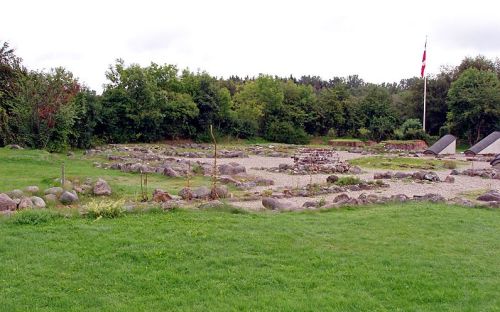
The ruins of Øm Monastery at Gl. Ry near Skanderborg. Photo Nico-dk Wikipedia.
The monks in Øm Monastery near Skanderborg supported Jacob Erlandsen in the dispute between the archbishop and the king.
A circumstance that further created problems for the monks was the suspicion that they had hidden Abbot Arnfast, who was accused of having assassinated King Christoffer 1. by giving him poisoned sacramental wine. A thorough search of the monastery, however, did not produce Arnfast, who had probably fled the kingdom.
But even though Arnfast was never found, the monks in Ømm had lost the queen's trust forever.
The Øm Monastery Chronicle laments that the Queen's army ate them out of the house on its way to southern Jutland in 1261, but rejoices that it subsequently turned out badly for her in the field: "When she at our expense for two nights stayed with us with 1600 riders in addition to the accompanying runners and infantry probably on their way into the field towards the Holstenians, which did not end so well after the battle of Lohede with her and her son being captured, even though Erik Abelsen had been appointed as Duke of Slesvig."
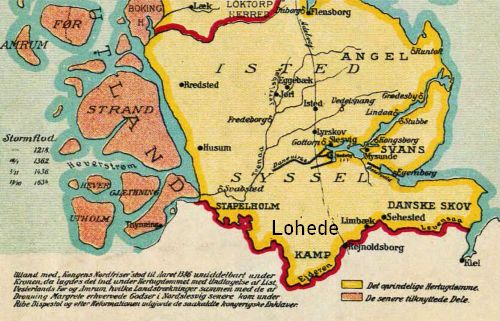
Map of the southernmost part of Jutland, also called Isted Syssel. Lohede is located northwest of Rendsburg between the river Ejder and the Sorg Å also called river Sorge. Photo Gustav Rosendal Wikipedia.
The royal army pushed into the duchy and pursued the duke south over Dannevirke. But here he received reinforcements from Holsten and turned around and delivered a battle on 28. of June 1261 on Lohede between Danevirke and the river Ejder west of Rendsborg. Other sources say that negotiations with the duke had already begun, when the Danes were unexpectedly attacked by the Holstenians.
The Danes suffered a catastrophic defeat. Drost Peter Finsen led the army as a whole, and Ivar Tagesen had command of the cavalry - they were both later hanged for conspiring with the enemy - probably in connection with their command of the army. The Danish losses were appalling and the young king and his mother fell into the hands of the Holstenians. It is said that during the battle Margrete rode a horse to death and thereby acquired her byname "Jumping Horse".
The royal prisoners were then imprisoned in Hamburg.
During Margrete's captivity, Jacob Erlandsen again stretched out his cunning in Denmark.
Abel's widow, Mechthilde - who hated Denmark - had sworn to live the rest of her life in chastity in a monastery, but the archbishop in 1261 succeeded in convincing her to say yes to a marriage proposal from the aging Swedish king-maker, Birger Jarl. Thereby Sweden became a solid support for the Abel lineage and an enemy of Denmark.
The future really looked bleak for Denmark in the autumn 1261. Everything had conspired against the little Erik Klipping. The Holstenians and Duke Erik Abelsen were invincible on the battlefield, Jacob Erlandsen was at large and making his sly plans in Denmark, the widow queen and the young king sat as prisoners in Hamburg - with no prospect that they would be released in the foreseeable future.
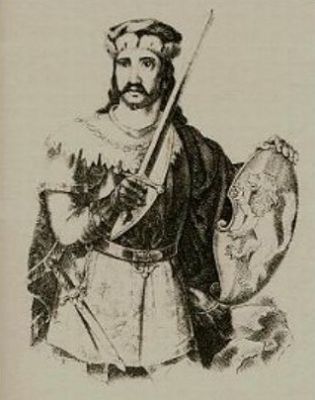
Albrecht of Braunschweig, who was Margrete Sambiria's cousin or half-brother on the mothers side. He was an experienced and effective army commander who did not go out of his way for anything. He had served under Christoffer 1. who had rewarded him with the islands Endelave and Samsø as fief. Albrecht's father was Duke Otto das Kind of Braunschweig-Lüneburg, who was Valdemar the Victorious' nephew and faithful ally to the very last. Otto participated in the battle of Bornhøved in 1227 on Valdemar the Victorious' side. Photo Wikipedia.
But Margrete had not lost the initiative. From her prison in Hamburg, she managed to send a prayer for help to her cousin, Duke Albrecht of Braunschweig.
Albrecht did not hesitate to come to the aid of his cousin. Late in the year 1261 he fell into Holsten with an army and plundered far and wide and before long the Holstenian counts were ready to negotiate.
The result was that both Margrete and the twelve-year-old king were released in exchange for that Erik Abelsen once again was confirmed in his position as duke of "Jutland", in addition he received the island, Als, and the crown's estates in the duchy. King Erik was to stay with Margrave Johan of Brandenburg until further notice as a hostage for peace.
Johan had in his first marriage been married to Erik, Abel and Christoffer's sister Sophia, so we must believe that the uncle took good care of the young king during his stay in Brandenburg.
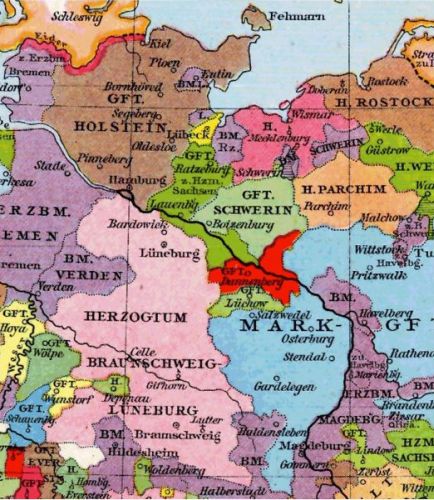
The duchy Braunschweig-Lüneburg about 1250. As I said, there are errors on the map as Fehmarn belonged to Denmark. Photo Gustav Droysen Allgemeiner Historischer Handatlas Wikimedia Commons.
Widow Queen Margrethe appointed Duke Albrecht head of the government and together they immediately went to Denmark, where they - probably in 1262 embarked on a much-needed and rather harsh clear-out.
The military leaders during the battle at Lohede, Ivar Tagesen and drost Peder Finsen, were arrested - allegedly for conspiracies. Margrete added accusations of treason during the Battle. Peter Finsøn offered the duke 10,000 marks for his life, but was rejected. He and Ivar Tagesen and six others were hanged near Nyborg. Ryd Monastery Chronicle for 1263 writes: "Reported King Erik's mother let Per Finsen hang".
The crown took back Kalunborg from Esbern Snare's daughter, Ingeborg, because her son supported Duke Erik. She later died in Slesvig. Ryd Monastery Chronicle writes for 1262 "In addition, Mrs. Ingeborg was expelled from Kalundborg." and later during 1267 "In addition, Mrs. Ingeborg of Kalundborg died in Hedeby."
Jacob Erlandsen's nephew, the bishop of Roskilde, Peder Bang Skjalmsen, was accused of having been in league with Jarimar at the battle of Næstved in 1259 and had to flee the country together with the archbishop himself.
The Lund Yearbook for the years 1262-63 describes dramatically how Duke Albrecht, together with the papal nuntius, Magister Gerhard and the Scanian nobleman Jon Litle should have deprived the priesthood of Sjælland and Lund of their estates and also imprisoned and looted the lower clergy: "- priests were shamefully imprisoned, their estates stolen, and all the evil which God allowed the duke and his companions to do is too much to report in detail." Until Albrecht "with great disgrace" left Denmark and "by God's just judgment fell into the margrave of Meissen's captivity," they added with malice.
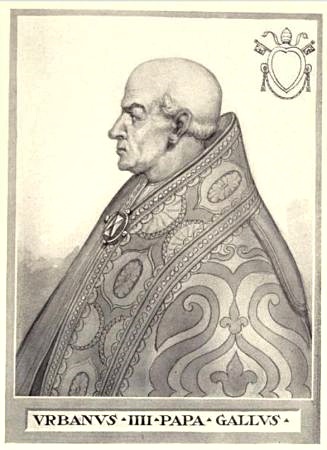
Pave Urban 4. 1261-1264. Photo Chevalier Artaud de Montor, New York: The Catholic Publication Society of America - Wikipedia
In 1263 a revolt broke out in Scania against the harsh methods of the new head of the government. The rebels captured Helsingborg and destroyed Åhus Castle. Margrete had to withdraw Albrecht's appointment. After some time he left Denmark - probably to take care of urgent problems in his own Braunschweig.
In the Braunschweig Rhyme Chronicle it is said that the widow queen herself had fallen in love with the brave and manly duke.
Margrete was determined to keep the Abel family away from the Danish royal power. Also in the year 1263 she took the completely unusual initiative of writing to the pope to get his assent that if Erik died without heirs, he could be succeeded by his sister. By all accounts, the pope accepted such an arrangement.
However, Erik did not die and furthermore he had several sons and a female succession was thus not necessary.
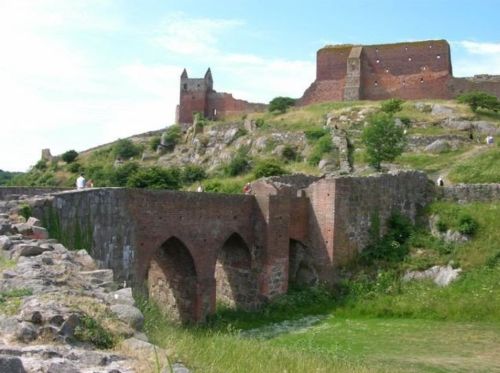
The ruins of the fortress Hammershus north of Allinge on the island of Bornholm. Foto Military Wiki.
In response to the government's complaint against Jacob Erlandsen, the pope had sent a magister Gerhard to Denmark to create order and peace, and according to the Lund Yearbook - as mentioned above - he must have been here in 1263. However, he could not get Jakob Erlandsen to follow his recommendations, and the result was that the pope in 1264 ordered Erlandsen to resign his office due to the accusations that were made against him and travel to the pope in Italy without delay.
But when the dethroned archbishop arrived in Perugia north of Rome in the fall of 1264, it happened that Pope Urban IV died. And the new pope, Clemens 4, turned out to have completely different ideas about Jacob Erlandsen's work. To him, Erlandsen was a true warrior of the church, whose cause was the cause of the whole church and the pope. He sent an even more senior envoy to Denmark, Cardinal Guido, with the task of ensuring that Archbishop Erlandsen and his followers could return to Denmark to be reinstated in their previous offices. Thereafter, damage compesations and the like were to be negotiated.
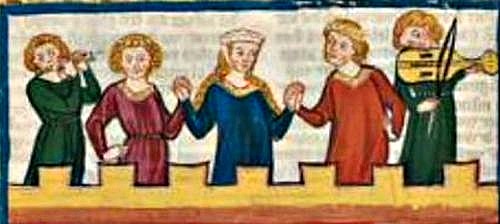
Medieval chain dance accompanied by flute and key-harp. Photo Rumelant von Sachen in the Codex Manesse.
About the same time as the cardinal came to Denmark, King Erik also returned to Denmark - 15-16 years old. Ryd Monastery Chronicle for 1264 writes: "King Erik was released from prison."
A condition of the young king's freedom was that he promised to marry Margrave Johan's daughter, Agnes of Brandenburg, without dowry. His mother, the widowed Queen Margrethe, was still his guardian.
Jacob Erlandsen may have accompanied the cardinal on the journey north. He stayed then in Lübeck with other exiled prelates.
In 1265 the castle Hammershus on the island of Bornholm was conquered by royal forces under Erik Klipping, but was given back to the archbishop in 1276.
Cardinal Guido had several meetings with the widow queen and the young king, but the negotiations did not make any progress, and any attempt to arrange a meeting in which Jacob Erlandsen could also participate ran into the sand. Guido suggested that they meet in Slesvig, but the king found the city unsuitable, declaring that there his safety would be threatened. He referred to the fate of Erik Ploughpenning.
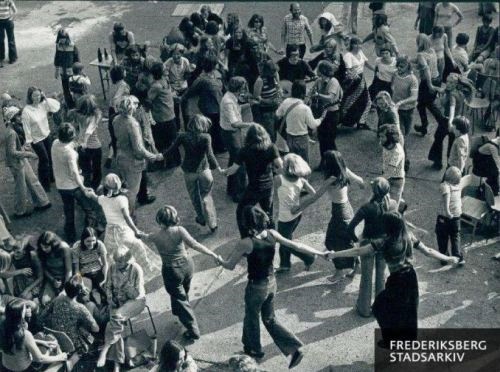
Graduation party with chain dance at Frøbel School in Frederiksberg in 1980. Chain dance is still part of the Faroe Island culture. Photo Frederiksberg Stadsarkiv.
The cardinal replied that if one were to find a place where a Danish king had not been killed, one would really be in trouble. But what about Ribe?
The fortifications of this city is too weak, replied King Erik.
In 1266 Pope Clemens 4. banned king Erik and the widowed queen and issued interdict all over the country in the hope of getting the negotiations going. But he succeded only to a small extent in getting the clergy to cease ecclesiastical activity.
Late in the year 1267 the Pope recalled Cardinal Guido: "- from these savage people who, to their own detriment, were so caught up in their delusions that they cared neither for rebuking nor for the blissfulness of their souls."
But it is obvious that the efforts to get Erik Ploughpenning declared a saint - and thus condemn the Abel family and thus win South of Jutland back as a natural part of the Danish kingdom - were completely derailed due to interdicts and excommunications and in general a problematic relationship with the papacy - all caused by Archbishop Erlandsen's excesses.
In 1266 the young Erik turned eighteen years old and was therefore declared of age. The widow queen handed him the formal power in the country and withdrew to the Christoffer family's castle in Nykøbing Falster. King Erik named her "Lady of Estonia", a task she actively and vigorously pursued. However, there is no doubt that she, as a gray eminence, still watched over Danish politics as well.
Many widowed queens in similar situations remarried. So did Mechtilde of Holsten and so should her own daughter-in-law, Agnes, also do. But Margrete Sambiria did not - perhaps she felt that Erik could still use a helping hand in critical situations.
Danehof was the medieval Danish parliament, a kind of forerunner of today's democracy. Every year the kingdoms noblemen and bishops met with the king i the city of Nyborg to discuss the management of the kingdom.
The Danehof as an institution undoubtedly originates from the organization of the royal household troops of antiquity.
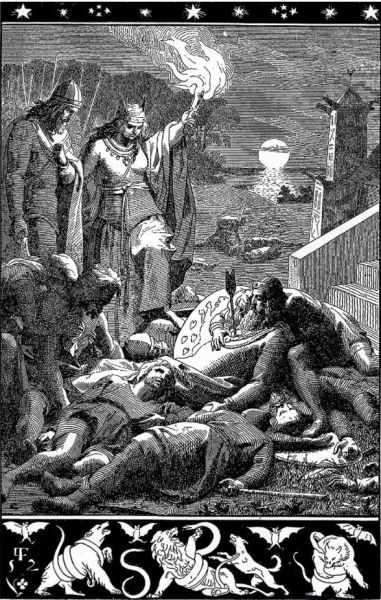
In their final stand, Rolf Krake's household troops fought to the last man in defense of their king. Hjalte's body lay at his feet and Bjarkes' at his head. Skade convinces herself that Rolf is really dead. PHoto Lorenz Frølich 1856. Wikipedia Commons.
The hird, the corps of househodls troops or tingmen, was organized as a military fraternity, of which the king was the most important member. The interrelationships between the members - including the king - were governed by a law that Saxo calls hirdskrå, Aggesen call it the Vederlaw.
Most early in the time of Canute the Holy, it became common for the king to send his sworn men, members of his household troops, out into the country to collect fines, lead the defense of certain parts of the country or cities, and perform similar tasks on the king's behalf.
The Historian Hal Koch wrote: "We stand here at the origin of the nobility or the class of lordship. There has been disagreement about the meaning of the Danish word "herremænd" (master-men). Some have wanted to put it in the context of the word "hær" (army), so that its basic meaning should be "warrior". However, it is probable that it means "en herres mand" (a lord's man), one who serves a lord to whom he is attached by oath of allegiance and certain obligations, first and foremost military service."
But as all the "herremænd" were thus bound together in a military fraternity, a common organization, together with the king, it was obvious that the more ordinary members of the hird had a certain influence. It was quite probable that they would meet from time to time to discuss their relations with one another and the state of the Kingdom.
Moreover, the king's men, the "herremænd", were exempted from tax on condition that they were ready for war when the king called. Therefore, it seems reasonable that they should occasionally show up and demonstrate their preparedness. In the time of Christoffer and Erik Klipping, these meetings were called "Herredage" or "Hof", the term Danehof came later.
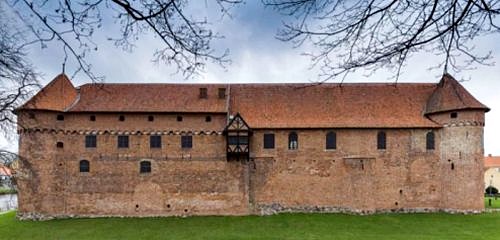
Nyborg Castle was built of burnt stone. At the time of Danehof, it must have been considered a modern technical marvel - an entire castle built of burnt stone! Photo Nyborg Slot.
The Danish bishops had to swear allegiance to the king, and they thus became part of the sworn fraternety around the king. This must be the reason why they were also invited to the regular meetings, which in Christoffer's and Erik's time took place in Nyborg.
Saxo describes that already in the time of Canute the Great there were special sections in the hird's rules for the crime of having violated the royal majesty.
During the time since Valdemar the Great, the kings had further developed the concept of "crimes against the majesty", which must have been developed on the basis of the Law of the military fraternity of the king's household troops. The definition of this crime was first and foremost attacks on the king's person or persons whom the king had taken in his defense. Such rules must have applied to the circle of the king's sworn men, but not necessarily to others.
It must be obvious that such legal rules still had great significance for the assembly in Nyborg, as it was precisely an assembly of the king and his men.
Already in the time of Christoffer, the assembly of nobles and bishops in Nyborg demanded a fixed procedure to be established for the trials concerning crimes against the majesty.
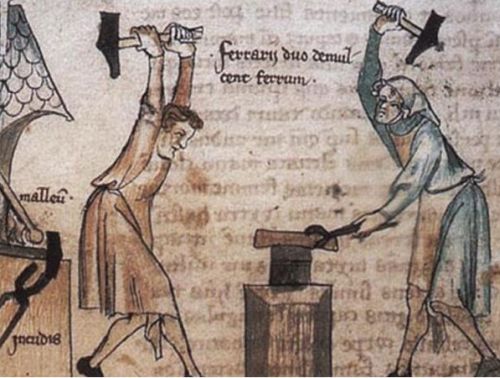
Medieval blacksmiths manufactured weapons and highly advanced armor in large quantities. Photo Randers i Middelalderen.
From Danehof in Nyborg in 1276, a national law is known that only contains rules on crimes against the majesty. It is said to have been given by "the highly nobleborn King's advisers and other good men of the Kingdom with the consent of the whole Kingdom" . It contains, first of all, rules of evidence in cases of conspiracy against the life of the king.
However, Abel avoided being convicted of the murder of Erik Ploughpenning in 1250 by mean of the so-called "double twelfth oath", which consisted of 24 knights, whom Abel himself had appointed, at the Ting in Viborg in 1250 swearing that Abel was an honest man and innocent.
If we are to believe the troubadour Rumelant, it was very important for Queen Agnes and her men that the accused in the murder of Erik Klipping in 1286 should not be convicted under this "Danish law", which allowed for the "double twelfth oath", but after another law, which must have been the law of crimes against the majesty, which was developed from the Law of the king's household troops and applied only to the king and his sworn men. And it did not contain anything about the "double twelfth oath".
Rumelant sang:
They still claim their innocence
and present their Danish law
-
No, it must go differently!
The accused for the murder of the king in 1276 were convicted by a "Worthældnævn" - a word-keeping board - which was a board of the kingdom's best men - quite certainly not appointed by the accused - which was to decide whether they had kept their word, in this case probably their oath of allegiance and their claim that they were innocent. Which procedure we can believe was part of the law of crimes against the majesty.
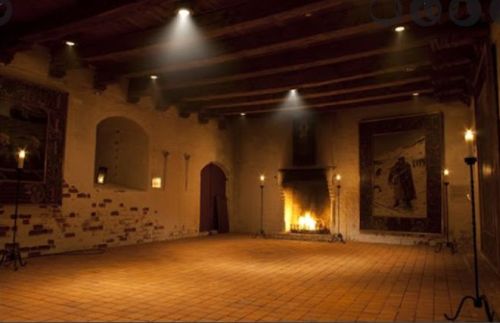
The Knights' Hall at Nyborg Castle where most of the Danehof meetings were held. Photo Smiling Denmark.
Denmark was still an electoral kingdom, and formally the kings were to be elected at all of Denmark's 13 country tings, which were Viborg Ting, Urnehoved Ting, Odense Ting, Ringsted Ting, Lund Ting and so on.
But no prince could hope to be elected on the tings if he had not secured the support of the great men in advance - for example, at the Danehof. In this respect, the Danehof functioned in the same way as the naval assemblies at Isøre did under Sweyn Estridson's sons.
In Erik Klipping's time, the Danehof assembly now demanded that a condition for them to support a king should be that he declared himself willing to follow certain restrictions in the exercise of his prerogative - that is, decisions that are not defined by law - defined in a contract between the king and the great men present - in the form of a "hand-binding" - which to some extent can be compared to a constitution.
The assembly accepted the royal court as a kind of supreme court, but it demanded that the king should only adjudicate in cases that had already been dealt with by another court. The king should only impose standardized fines and penalties.
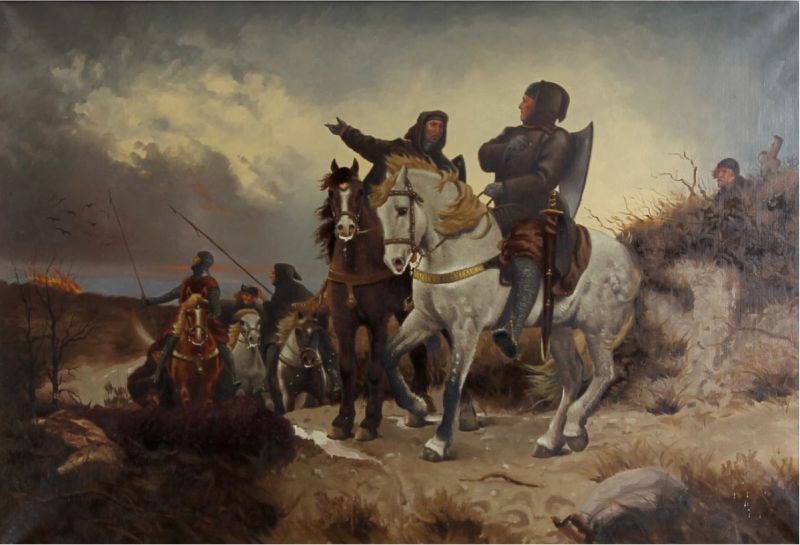
One of Denmark's most famous paintings: "The conspirators ride from Finderup" by Otto Bache, 1882. The picture is unhistorical, as most of the conspirators were not convicted of having committed the murder "by themselves" but for "by counsel, command, and action to slay him" . Marsk Stig and Jacob af Halland were not present in Finderup at all. Photo Carsten Wikimedia Commons.
The English Magna Carta from 1215 was mainly a protection of the rights of the barons in relation to the king's power, and Erik Klipping's "hand-binding" from 1282 was certainly also a protection of the nobility and the rights of the great men. But it still contains an astonishing number of measures for the protection of the rights of ordinary peasants, such as:
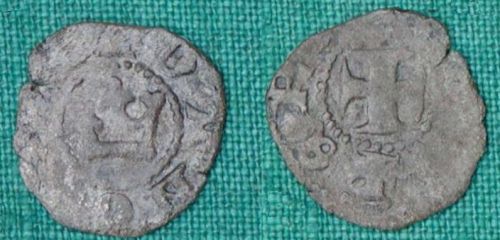
A coin minted under Erik Klipping - front and back, found in Ribe with detector. The historian Ole Fenger writes that the coins deteriorated by 1/3 of their value under Erik Klipping. Photo SOL Samlingen OnLine.
- No one should drive for the king, his wife, children or the drost outside their own shire.
- Peasants should not be forced to build or improve the king's castles, mills or other buildings without in emergencies.
- Peasants should not be forced to bring geese, chickens, to the king's table beyond what was customary in King Valdemar's days..
- The king's ombudsmen must not summon anyone to themselves, but to their own ting.
- No one should forcibly guest monasteries, churches or private persons, but let themselves be content with what the headmaster has and wants to give.
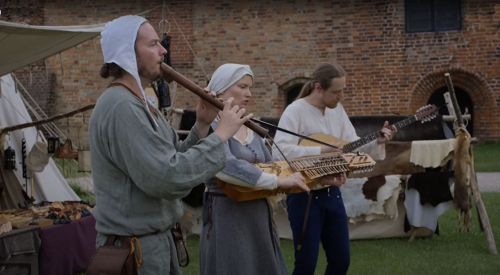
A band plays medieval musical instruments at the Danehof Festival in Nyborg. From left to right: Flute, key-harp and lute. Photo Visit Nyborg.
The Danehof's most famous decision was made in 1282, when Erik Klipping's hand-binding was adopted in Nyborg also by the king. It was also settled that Danehof should take place every year.
The hand-binding, which was adopted in 1282, states, among other things: "that once a year the assembly, called Hof, shall take place at mid-fast, still that no one may be imprisoned unless he has voluntarily declared guilty in a ting, legally convicted of or caught red-handed in a crime for which he must, according to the laws of the land, lose life and limb, but the legally convicted must have the opportunity to flee the kingdom, as stated in the law books." - "Still, no man for any offense shall lose his land unless he is convicted of a crime against the majesty by oath of Worthældsnævn (that is word keeping board)."
The most famous of these cases took place in 1287, when Jacob of Halland and Marsk Stig Andersen along with seven others were convicted outlaws for the murder of their king, Erik Klipping.
In Viking times, the individual parts of the country were ruled by earls, who were appointed by the king and referred directly to him. A position as earl was not automatically inherited by the earl's sons and descendants. But it has probably always been every earl's hot wish that they could pass on their position to their sons without complications.
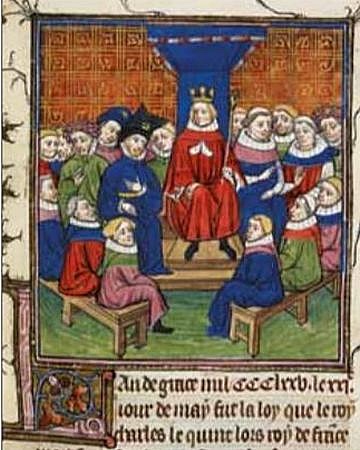
En konge i parlament. Foto Fransk håndskrift fra middelalderen - British Library.
It was a problem already under Valdemar the Great. Saxo says that Buris Henriksson's precondition for paying tribute to Valdemar's seven-year-old son, Canute, as king, was that his own position should also be hereditary: "To free himself from this suspicion, Buris promised that he would do what the King wanted, if he would increase his power by giving him more fiefs and giving the children of his kinsmen right to inherit the dignity that their fathers had; just as he himself sought to make Denmark into an inherited kingdom, whereas it had previously been an electoral kingdom."
It was precisely Margrete Sambiria's and Erik Klipping's great problem that Valdemar the Victorious had so generously distributed parts of the country in the form of the prince-fiefs to his many sons and their descendants, thereby significantly reducing the royal revenue. Which - along with the increasingly extensive church estates, which also reduced the royal revenue - had made the country more unstable, because the king no longer had the finances to pay so many soldiers that he could defeat any possible rebels with overwhelming force.
In 1266 the young Erik Klipping was declared of age and he thus took over the government after his mother, Margrete Sambiria.
Pope Clemens 4. made several attempts to get Jakob Erlandsen reinstated, but Erik ignored all approaches. In 1266 , the pope banned King Erik and the widow queen and declared interdict throughout the country because Jakob Erlandsen had been expelled.
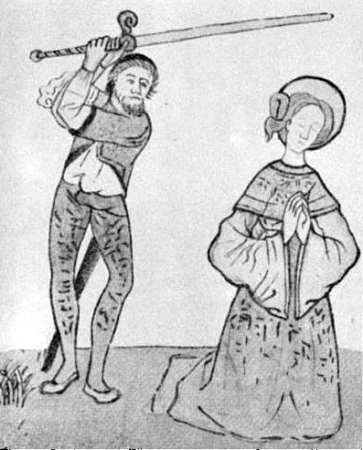
A female thief is beheaded. The person to be executed, however, usually had blindfolds and hands tied on the back. In traditional land laws, a thief is a thief regardless of gender, the punishment is hanging in gallows and branch. But in some cities, male thieves were hanged, while female thieves were executed with swords. This applied, for example, to Malmö and Copenhagen city courts. In Ribe, female thieves were buried alive under the gallows with an inverted tub over their heads. In common reputation, execution by sword was far more honorable than hanging. Photo Watercolor in the National Museum of a fresco in Roskilde Cathedral. After Troels-Lund.
King Erik built the castle Koldinghus. Ryd Monastery Chronicle for 1268 writes: "King Erik Christoffersøn built Koldinghus."
It was at the Danehof in 1269 that Erik Klipping issued the infamous Ribe Law, which was largely inspired by Lübeck's city Law, although it was far from a copy. The Ribe law was adapted to the city's old legal customs, older privileges and Jutland Law.
The special thing about Ribe Law in relation to Jutland Law was that Ribe Law allowed greater severity in its punishments for wounds and killings. While Jutland Law gave killers the opportunity to escape with fines or to be declared outlaw, Ribe Law could give sentences to death.
The penalty for killing was a recurring point of contention between the king and the danehof assembly. The king wanted stricter punishments, while the assembly kept to the old laws, which said that if the killer immediately announced the killing at the nearest inhabited place or for the victim's relatives, it was an honest killing that could be penalized with fines. If the victim's family did not accept the fine, the killer could be sentenced outlaw and then anyone - including the victim's family - could take revenge on him without further legal consequences.
Some verses of the folk song about Toben's daughter illustrate the blood revenge:
We were so many little siblings,
- at the hillside -
so early we lost our father.
Daylight is growing and the dew is wet all over.
On a Sunday night, they scrubbed their spears,
on a Monday morning they rode out so angry.
There they came to the north forest,
There Mr. Torben went and held his plow.
"Here you go, Mr. Torben, beautiful and fine!
I will now have penance for my cousin!"
"I will give you house and farm,
to that my daughter, so beatiful a marten."
"We have not come for house or land,
but we have come for the blood of your heart."
Then they chopped Mr. Torben so small
all like leaves, in the grove lay.
The kings tried to smuggle the harsher punishments for killing in through the back door for example through the city laws or by making it more reprehensible to kill in special places, for example in churches.
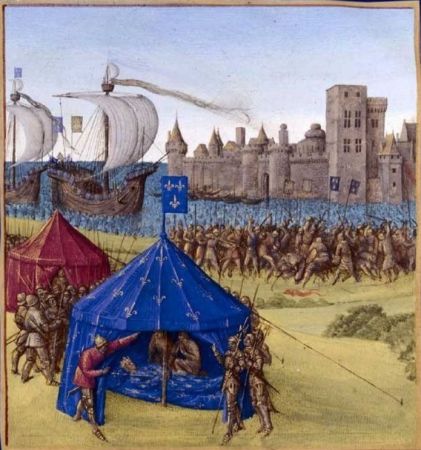
The death of Louis 9. at the siege of Tunis during the 8. Crusade in 1270. Photo Jean Fouquet - Grandes Chroniques de France Wikipedia.
However, Jakob Erlandsen had the misfortune that his benefactor, Clemens 4, died in 1268 and the papacy then stood empty for more than three years. Although a new pope was elected in 1271, he was on a crusade in the Holy Land and had to be called home first, which meant that the papal court could not resume its normal functions until 1272.
The new pope, Gregory 10, was passionate about the Crusades and wanted to gain the support of all secular princes for that under direct papal leadership. Thus, it was not very likely that he would seriously confront the secular princes, including Erik Klipping.
In 1272 died "the Duke of Jutland", (by which is meant Southern Jutland) Erik Abelsen - only 30 years old. He was survived by two minor sons, Valdemar and Erik. The king immediately took possession of the whole of Southern Jutland. However, he agreed to promise to grant the eldest son Valdemar Eriksen with his father's duchy, but, such that the king got Als and the crown estate back, which the duke had acquired as a condition of the widow queen and king's release from captivity in Hamburg in 1262 after the Battle of Lohede. In addition, the king was to be the guardian of the minor ducal sons.
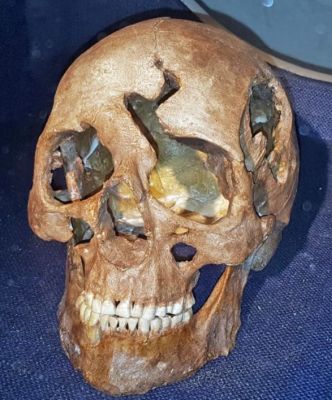
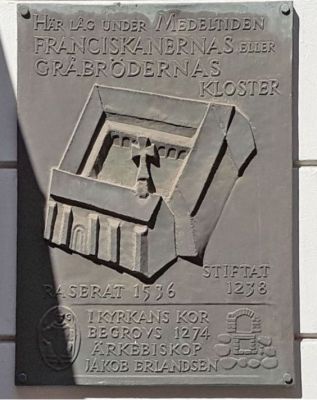
|
Left: Jacob Erlandsen's skull. There are clear signs that he was killed with a shot from a crossbow
During excavations for a district heating pipeline in Klostergade in Lund in 1972, several medieval tombs were found in the area of the Franciscan Monastery Church, which was demolished in 1500, one of which was larger and much more special than the others. It contained a chest tightly packed with the bones of a man, 60-70 years old and 170 cm tall. It had been necessary to puncture the skull in the forehead to make room for a femur. But two other holes on the right and left temples, respectively, were more interesting. A forensic specialist determined that the large hole in the left temple had been blown with great force from within. This can be explained by the fact that the smaller rhombus-shaped hole in the right temple is a characteristic entrance hole for a crossbow bolt. Since the bolt has thus gone straight through, one must believe that the shot was fired at quite close range.
If a very noble person in the Middle Ages died far from his home, one could simply part the body and boil the body-paers in order to separate the soft tissue from the bones. Then they just home the bones only packed in a small practical box. And that's what happened to this person. Jacob Erlandsen died on the Rügen and from there his bones were sent to his archbishopric in Lund.
Jacob Erlandsen was buried in the Franciscan Monastery Church in Lund at his own request, and since the skeleton has been found in a very central place, it is likely that it really is him. Photo Lund Turistinformation.
Right: Memorial plate for Jacob Erlandsen. Photo Lund Turistinformation.
Perhaps in 1273 the new pope succeeded in creating a settlement between the Danish government and Jacob Erlandsen. It was agreed that the details of the settlement should be decided by Danish clergy. The injunctions and interdicts that were issued were temporarily suspended until they had been dealt with by a group of cardinals in Rome.
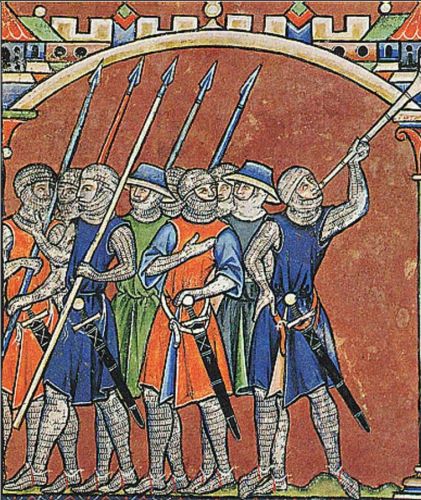
Soldiers in chain mail in the Maciejowski Bible reportedly from 1244-1254. Photo Maciejowski Bible Morgan Library Wikimedia Commons.
Now Jacob Erlandsen could finally start his way back to Denmark for honorable rehabolitation after seven years of exile. But he came only to Rügen, for there, on February 18, 1274 he was killed with a shot from a crossbow on close range in the right temple.
We remember the last sentence in the list of complaints that the Danish envoys brought with them when they traveled to the Pope in 1261 to complain about the archbishop: "But separately, his breach of fidelity and fraud must be dealt with."
It may have been King Erik who was behind this killing, but his mother, Margrete Sambiria, was still active from the castle in Nykøbing Falster, and she had probably not forgotten that it was Jakob Erlandsen who was behind the murder of her husband 15 years before.
The bishop of Roskilde, Peder Skjalmsen Bang, has probably accompanied Jacob Erlandsen on the journey home from Rome and most likely there experienced Erlandsen's final, which probably made a big impression on him. As early as May 1274, a settlement was reached between Peder Bang on the one side and the King and his mother on the other. The conditions are not known, but the bishop seems to have been satisfied, perhaps mostly because he was tired of the struggle and frail, for only three years later he died. Ryd Monastery Chronicle writes for the year 1278: "Bishop Peder of Roskilde died".
The following year, the pope definitively repealed the interdict and the bans, and then this long-standing problem was out of the world. That same year, Erik Klipping began the crusader taxation of the Danish clergy, probably in agreement with the pope.
Stig Andersen was the leader of the army that the king sent to Sweden in 1275 to help Birger Jarl's sons, Magnus and Erik, in the battle against the brother, Valdemar Birgersson. He won the battle of Hova. That same year, the king rewarded him with the position of marsk - leader of the kingdom's armed forces.
But already the following year, in 1276, Stig Andersen showed defiance against King Erik, as he at the Danehof in Nyborg refused to make an oath to his young son, Erik, as the other great men did. Lunde yearbook for 1276 says: "The king's son, Erik, was given the royal name and the great men except Stig, his marsk, made a solemn oath of allegiance to him."
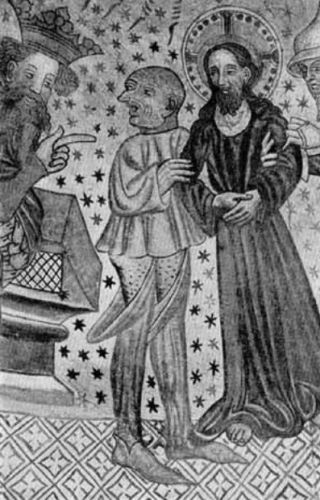
Hoseøl was Peder Nielsen's nickname. That means garters. Fresco in Kongsted church near Fredericia from around 1450 which shows Jesus brought before for King Herod. The soldier is wearing trousers that hang loosely at the top. This was the situation that Peder Nielsen Hoseøl wanted to avoid by using garters. Modern women's combination of hip holder, garters and nylon stockings existed in principle as early as in the Middle Ages. Medieval hoses were sewn from leather, cloth or other inelastic fabric. The leather hoses could be colored fiery yellow, red, parrot green, pink or white. But not only that, each leg could have sepsrate color; or they could be striped in different colors. Photo "Strømpen i den europæiske modedragt" by Ellen Andersen.
Stig Andersen had married into the Hvide family; perhaps he wanted to demonstrate his commitment to his new distinguished lineage. However, he kept his position as marsk.
In 1278 , King Erik replaced the drost - a kind of prime minister - Uffe Nielsen, with Peder Nielsen Hoseøl. Uffe Nielsen was Marsk Stig's father-in-law, while Peder Nielsen Hoseøl is said to have been a steely and tough man who steadfastly supported the king.
In 1273, the German princes elected Rudolf of Habsburg as their king after the German territory had been without either emperor or king since Konrad 4. died in 1254. During this interregnum, the great principalities had threatened to engulf the smaller ones, especially the cities. King Rudolf therefore in 1280 appointed the Dukes of Sachen and the Margraves of Brandenburg as defenders of the cities. Surprisingly, this initiative led to war between Brandenburg and the Slawian princes of Rügen, Werle, Schwerin, Rostock and Mecklenburg supported by Sachen.
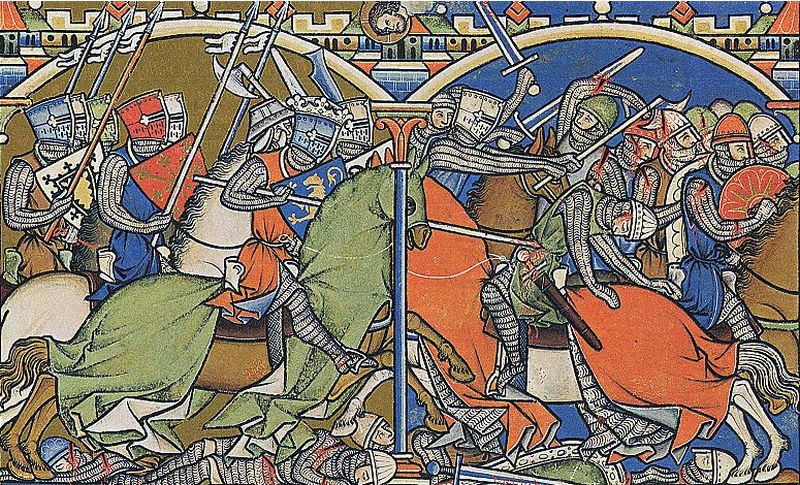
David defeats the Philistines in the Morgan Bible also called the Crusader Bible which is said to be from around 1250. Photo Maciejowski Bible Wikimedia Commons.
A papal letter from 1281 mentions cattle plague and famine in Denmark.
At the Danehof in the summer 1282 we meet for the first time the term "hand-binding". The king agreed that every year danehof should be held. This triggered a host of detailed provisions: If anyone wants to accuse the king of unjustly depriving him of any property, it is at Danehof that the king must stand up for it and submit to the judgment of his faithful men. The royal court was only allowed to rule in cases that had already been heard in another court. The amount of poultry that was to be delivered to the king's table was cut. The leding tax was changed so that small landowners became completely free of theis tax. The duty of the peasants to drive for the king was limited to their own shire. The nobles would no longer do garrison service on the king's castles and so on.
In December 1282 widow Queen Margrete Sambiria died in Bad Doberan. Ryd Monastery chronicle writes for this year: "In addition, Queen Margrethe died"
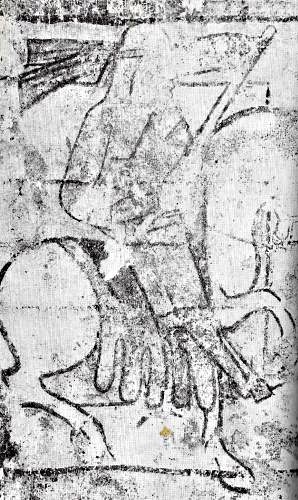
Fresco of a rider from the 1200 century in Tulstrup church between Aarhus and Silkeborg. In 1904, a number of frescoes from the early 1200's were found in Tulstrup Church, which were estimated to be so poorly preserved that they were overpainted again. Among the paintings, however, this rider was photographed in armor with a waving banner.
Again in 1283 a papal letter tells of a great famine in Denmark.
After the common German king, Rudolf, in 1283 once again called on his princes for peace, Brandenburg's many enemies - that is, most of Denmark's southern neighbours - entered into an agreement called the Land Peace League, which was aimed against Brandenburg, and thereby also against Denmark, which had a special relationship with Brandenburg.
The treaty was essentially a mutual agreement on military assistance, but the participants also undertook to ensure trade and road peace and to punish criminals. Criminals, who were declared outlaws in one member state, should also be outlaws in all the other member states.
The League placed great emphasis on peace and justice: "Still, all roads in the said countries must be peaceful for road users in such a way that if anyone suffers loss or damage to his property or person, everyone to whom the victim's scream or cry of distress thus reaches must strongly and with all force pursue him or those who have caused the damage."
In the summer of 1284, the Land Peace League made peace with Brandenburg that thus joined the League's regulations. Likewise, Duke Valdemar of "Slesvig" joined the League as if he represented an independent principality. On the other hand, it was specifically mentioned that the Danish king could only be admitted when "he would remain in justice".
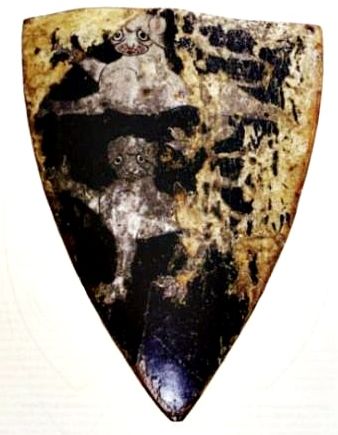
The knight Vogte von Keseberg's shield from around 1250 in Marburger Universitatsmuseum für Kunst- und Kulturgeschichte. Photo: Svenia Kohlmorgen Pinterest.
The justice that the members of the Land Peace League missed in Denmark had nothing to do with highway robbers. The fact that the Duke of Southern Jutland could be admitted as "Duke of Slesvig" - but not the King of Denmark - clearly indicates that the lack of justice was connected with Margrete's and Erik Klipping's efforts to abolish the princely fiefs that Valdemar the Victorious had given to his sons to the great detriment of Denmark, including Halland, Blekinge and Southern Jutland.
The most offensive "injustice" was without a doubt Erik Klipping's possession of the duchy of "Jylland" (that is Southern Jutland) - which was perceived as an injustice by the dukes themselves and most likely also by their close allies, the Holsten counts, and other German princes. The retention of Erik Ploughpenning's daughters' inheritance and dowry was probably also on the list.
Churches and monasteries' tireless complaints about Margrete's and Albreckt's seizure of church property on Sjælland and in Scania in 1262-63 and the expulsion of Jacob Erlandsen, Peder Bang Skjalmsen and their followers the same year were undoubtedly also noted as "injustice" by members of the Land Peace League. The elimination of Jacob Erlandsen in 1274 was probably not very popular either.
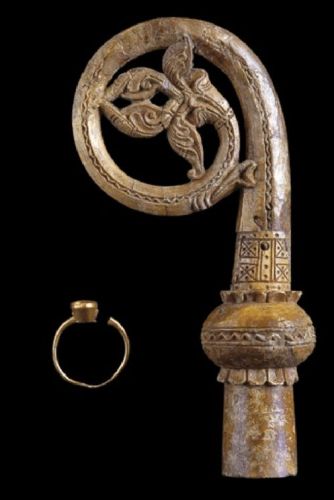
Bishop's staff of walrus tooth and ring found in Bishop Olafur's grave in Gardar in Greenland from 1246-1280. Photo Nationalmuseet København.
The Land Peace League represented a serious foreign policy squeeze on Denmark. Previously, one could take advantage of disputes between the German states, ally with some and confront others, but now you were faced with a united bloc at the same time as Denmark had problems with both Norway and Sweden.
Under these circumstances, Denmark could forget all about including Southern Jutland as a natural part of the kingdom merely by mean of military power. It would have been perceived as a serious violation of justice and would have alerted all the principalities and towns of Land Peace League in northern Germany, who would rush to the aid of their dear ally, Duke Valdemar.
Instead, Erik and his advisers wanted Denmark to also be a member of the Land Peace League. King Erik reached a preliminary agreement with Lübeck in September 1283 and full membership of the League succeeded in November 1284.
But how was Denmark able to convince the princes of the Land Peace League that "justice" now reigned in the country?
One might think that in these critical years - 1283-1284 - the Danish government, with the help of political concessions, diplomacy and propaganda, averted a dangerous situation for Denmark. The military alliance that the Land Peace League really was could have used Holsten and the Duchy of Jutland as stepping stones and springboards to subjugate the rest of a weakened and politically isolated Denmark.
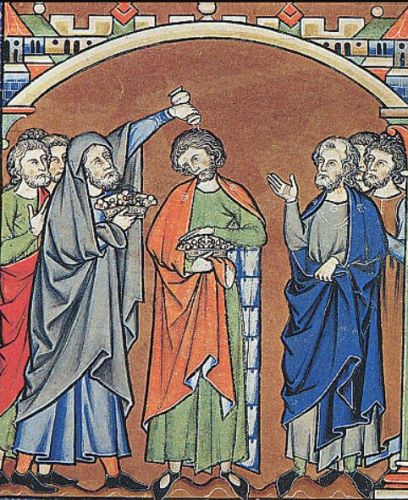
Miniature from possibly 1250. A priest anoints David king over all Israel. Photo Maciejowski Bible Wikimedia Commons.
Such plans were not unknown in the Germany of the time, Denmark must have appeared as a tempting prey.
The historian Hans Olrik tells that Albrecht of Braunschweig - in February 1262, before he came to the aid of Margrete and Erik in their captivity in Hamburg and then became head of the government - had made plans to conquer and share Holsten and Denmark with his German allies, who were his brother Johan, his sister Helene of Sachen and her sons, Dukes Albert and Johan.
The first move of the Danish government was to satisfy the duke, Valdemar Eriksen - at least so much that he could not shout his unfair treatment all over northern Germany.
In the spring of 1283, Valdemar Eriksen was given the duchy of Southern Jutland, which his father had had, at a national meeting in Vordingborg. Yet still without Als and the crown's estates, which King Erik had reserved for the kingdom. This was confirmed at Danehof the same year.
It was not, however, that the Duke became satisfied. Apparently he never was. He went home to his newly built Gottorp Castle and wrote a long letter of complaint to the archbishop, in which he claims the throne of Denmark and asked him to write to the pope about his unjust treatment. It reads, among other things: "But since then their uncle King Christoffer" - "has been elected and crowned king" - "although he, as their uncle, had given his consent for their father and his descendants to have the kingdom" - "and though a negotiation has recently taken place which should be more solemn and which was confirmed by many oaths on their part that all their fathers' estates should be given and handed over to them, the king has nevertheless broken his oath and is still withholding much of their estates in various places" - "And since they have so often and frequently by the king and his mother the queen's betrayal have been deceived" - "as protest that they intend to claim the Danish crown with all their rights and pursue the case as far as they can." (After Huitfeldt following Troels Brandt).
The letter can probably only be described as high treason, especially since Valdemar had just taken the oath to King Erik as Duke of "Jutland".
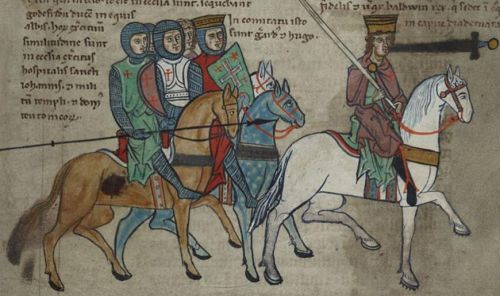
Cavalry from around 1250. Photo Expositio in Apocalypsim Cambridge University Library.
At about the same time in 1283 - probably in the spring - the king's solid support, Peder Nielsen Hoseøl, resigned as drost and was replaced by Erik Knudsen, who was Valdemar the Victorious's grandson and thus one of the king's relatives who have been denied the fiefs of their fathers. Erik Knudsen's father was Valdemar the Victorious's illegitimate son, Duke Knud of Blekinge. He was without a doubt far more acceptable to the the Land Peace League than Peder Nielsen Hoseøl.
However, the Danehof assembly in 1284 gave him "justice" and granted him the four southernmost shires in Halland as the Duchy of South-Halland. Probably for this reason, he was already this year replaced as drost by Marsk Stig's father-in-law, the experienced Uffe Nielsen, who apparently was also quite acceptable to the Land Peace League princes.
Only 11 days before the agreement with Lübeck was signed, also in 1283, Jacob of Halland was handed over the duchy of North-Halland, which he considered to be his fair ancestral inheritance - with the participation of Duke Valdemar of Southern Jutland, Count Gerhard of Holsten and Prince Vizlav of Rügen. It can hardly be described as a coincidence.
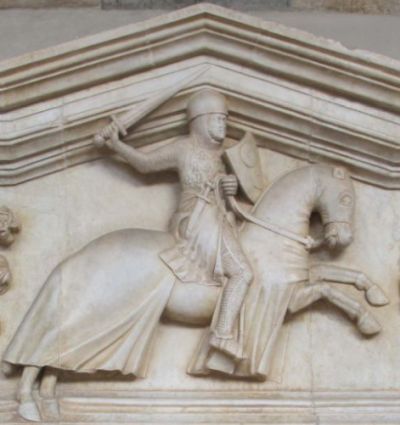
Guillaume Bertrand de Durfort as a typical knight from around 1250 on his tombstone in the Santissima Annunziata Basilica in Firence. His fame is due to his participation in the Battle of Campaldino in June 1289, in which he lost his life hit in the eye by a crossbow bolt.
Photo I Sailko Wikimedia Commons.
Further, also in the spring of 1284, Marsk Stig and Count Jacob of Halland were judges in an arbitral tribunal which gave the two unmarried Erik Ploughpenning's daughters their inheritance.
King Erik seemed to promote such men as could be assumed to be acceptable to the the Land Peace League princes. Among the signatories for Denmark to the Land Peace Treaty itself in November 1284 were thus Marsk Stig, Jacob af Halland, Niels Knudsen and Peder Jacobsen, which persons must have been regarded as particularly zealous supporters of "justice", which may have given the princes of the Land Peace League the impression of that "justice" had made great progress in Denmark. They were all later outlawed in connection with the later assassination of king Erik.
One might think that King Erik's political turnaround in these years was a manifestation of realpolitik, but one might also think that after his mother's death he simply found a pretext to throw in the towel into the ring.
In the cardinals' final report on the case that Archbishop Jens Grand brought against king Erik Menved in 1296 states about Erik Klipping: "Relatives of this Archbishop (Jens Grands) - namely Count Jacob, Marsk Stig, Peder Jacobsen, Rane Jonsen and several others of their family and relatives, they were noble of lineage, but unlucky and brought unluck in deed. The king made them rich above all the king's faithful supporters of the kingdom - and he installed them as masters over all the income and earnings of the land, so that he reserved for himself only the royal name."
In August 1284 - only three months before the signing of the Land Peace Treaty - the king gave all German cities the right to trade on the Skanør market.
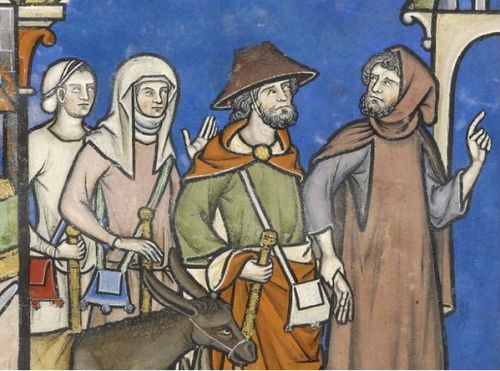
Civilians in miniature in the Maciejowski Bible which is said to be from around 1250.
Photo Thorn and Thread.
However - probably in frustration and annoyance that he had not become king with German support - duke Valdemar Eriksen raised demands that his Duchy of Southern Jutland, which he called "Slesvig", should also include Als and the crown's estates. However, this was rejected by a so-called vortelnævn, whose verdict was confirmed at the Danehof in Nyborg in 1285.
Then also in 1285 - it is said - he sought to take possession of Als with military means, in that connection he declared that the Danish crown belonged to him. Erik Klipping easily defeated the revolt with his loyal German mercenaries. The duke tried to flee to Norway, but was apprehended in Elsinore.
But now it was Erik Klipping who had "justice" on his side, Duke Valdemar had rebelled against his rightful master. He did not hesitate to arrest him and put him in prison in Søborg Castle in North Sjælland south of Gilleleje, conveniently far from Southern Jutland and Holsten.
Ryd Monastery Chronicle writes for the year 1285: "The king captured Duke Valdemar near Elsinore and sent him in chains to Søborg."
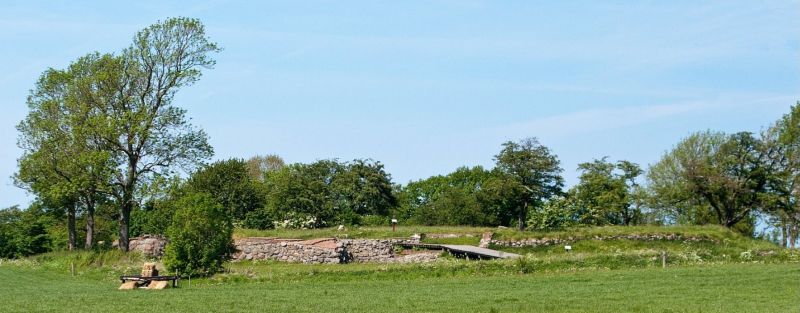
Søborg castle ruin south of Gilleleje. Photo Knud Winckelmann Wikipedia.
However, already the following year, in April 1286, he was released - apparently at the intercession of the Princes of the Land Peace League, on condition that he swore to renounce all his claims and be faithful to his king. He swore that in all future he would be the king faithful and obedient and never strive the king for life or freedom and if he broke his words he promised that all his estades would be the king's and he himself would be executed. The Duke of Sachen, the Holsten counts and the Mecklenburg princes guaranteed Valdemar's allegiance. There were no Danish guarantors.
In connection with his release, Erik Klipping gave him the proceeds of the minting and the leding replacement tax in the duchy, although this was not included in the Danehof's decision in 1283 - as a gesture - characteristic of Erik and his policies - in hopes of reconciliation and future cooperation.
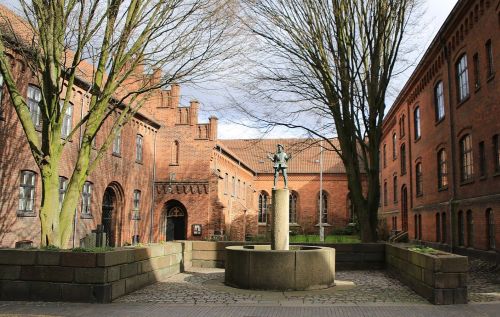
Greybrothers Monastery in Odense seen from Jernbanegade. In 1285, Erik Klipping donated his royal site in Odense with everything which belonged to it to the Franciscan monks, deciding that he should be buried there - he even let his will declare on ting. After the color of their dressing, the Franciscans were called Gray Brothers, hence the name of the monastery. King Erik did not get his wish fulfilled, as he was buried in Viborg the following year due to the old custom that kings who died an unnatural death should be buried where they fell. The statue depicts King Christian 3. who in connection with the Reformation came into possession of all church property, but gave the Gray Brothers monastery to the city of Odense as a hospital. Photo Kåre Thor Olsen Wikipedia.
The town of Lübeck was very active in the creation of the Land Peace League and the Lübeck merchants must have seen clearly that such a peace characterized by compliance with the laws and by clear agreements across principalities and kingdoms was very beneficial to their trade.
As early as 1283, when the Land Peace Treaty was created, the start of the Hanseatic League was being formed. In 1241, the first alliance between Lübeck and Hamburg was concluded, when they agreed to jointly protect trade routes at sea and on land, especially in the lawless territory between the Elbe and Trave. Osnabrück joined them in 1246. Goslar, which was the center of the copper mining operations in the Harz, joined the group in 1268.
The orderly conditions under the Land Peace Treaty created fertile ground for the emerging Hansa League, consisting mainly of northern German cities, the Land Peace Treaty states, the treaty said: "How great is the benefit of peace for people and countries where peace reigns - no sensible man is ignorant of this."
Sweden in the older Middle Ages was not a stable state formation until the middle of the 1200's, although the landscapes Svealand around Mälarn and the Götalands around the great lakes were often united under the same king. The two royal dynasties, the Eriks lineage and the Sverker lineage, fought for power and took turns delivering the royal candidates.
But in 1250 Sweden's most powerful man, Birger Jarl, disregarded the two traditional royal families and put his own seven-year-old son, Valdemar Birgersson, on the throne.
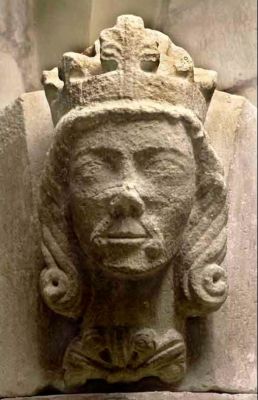
Valdemar Birgersson in Skara domkirke identified by Prof. Jan Svanberg. Photo Ragnar Sigsjö for Southerly Clubs Wikipedia.
In his first sixteen years as king, his father was the real regent. In 1260 , seventeen years old, he married Erik Ploughpenning's dominant and qick-witted daughter, Sofie, who was about two years older than him.
In 1261 - while the widow queen Margrete and the young Erik sat as prisoners in Hamburg - Jacob Erlandsen succeeded in convincing Abel's widow, Mechthilde - who hated Denmark - to leave her chaste monastic life as a nun and say yes to a marriage proposal from Birger Jarl. Thereby, Sweden became a support for the Abel lineage against Denmark.
Birger Jarl died in 1266 and then Valdemar Birgersson ruled all of Sweden at that time.
However, Queen Sofie's little sister, Jutta, who had been placed in a nunnery, did not feel comfortable with the regularity and sexual abstinence of monastic life. Around 1270 she broke her vow and left the monastery in Roskilde with her little sister, Agnes, which attracted some attention in those days.
Jutta traveled to Sweden to visit her older sister, Queen Sofie. She was warmly received by Valdemar Birgersson, so warmly that she became pregnant. The prioress in the monastery in Roskilde complained to the pope because according to church law, sexual intercourse with a wife's sister was incest. For the same reason, the Swedish nobles forced King Valdemar to make a penance trip to Rome.
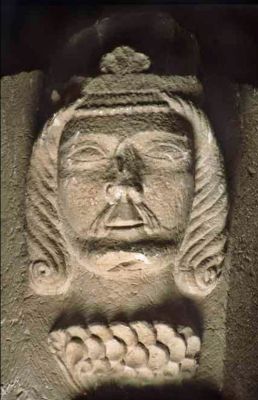
Magnus Ladelås in Skara Cathedral identified by Prof. Jan Svanberg. Photo Ragnar Sigsjö for Southerly Clubs Wikipedia.
But, while Valdemar Birgersson was on his penance journey, his brothers, Erik and that Magnus, who would later be bynamed Ladelås, prepared a coup against him. They sought and received help from Erik Klipping in Denmark in the form of hiring 100 fully equipped riders and 700 foot soldiers for payment of 6000 marks of silver. The force was led by Count Jacob of Halland and Stig Andersen.
They defeated Valdemar's peasant army at the Battle of Hova 1275 near Tiveden between the lakesVänern og Vättern, while Valdemar himself slept in a village not far away with Sofie. Ryd Monastery Chronicle writes: "There was a battle at Hofva and the Swedes were thrown on the run by the Danes."
Magnus Ladelås became King of Sweden, and his brother became Duke of Sweden, but died shortly after. Ryd Monastery Chronicle writes for 1277 "Duke Erik of Sweden died. It is said that Queen Sofie should have said: "Woe to me. I never overcome that grief. Woe to me that my sister ever saw the Kingdom of Sweden".
The dethroned Valdemar then began to live openly with his mistresses, prompting the bishops to criticize him for having displaced her. In 1277 Sofie returned to Denmark.
However, King Magnus flatly refused to pay the agreed 6000 marks of silver to King Erik. Instead, he lamented the devastation caused by the Danish aid force - in response that they did not receive their salaries - and launched a war against his former support in the autumn of 1276 - completely surprising - by moving into Halland and Scania and ravage these provinces without meeting resistance.
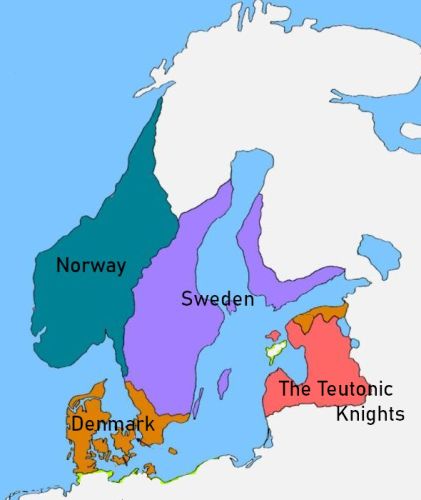
Scandinavia in the late 1200's. Birger Jarl had just begun the crusades towards Eastland, that is Finland, so perhaps the Swedish area in today's Finland is too large. As can be seen from history, the Danish king did not have full control of the Rügen, but the island had for several hundred years traditionally been considered to belong to the Danish king. Estonia belonged to Denmark. It is very uncertain how far north the Norwegian king's authority reached. Photo MasterOfHisOwnDomain Wikipedia.
Erik Klipping had been taken on his bed. No one had imagined that Magnus would turn against Denmark. But soon a force was mobilized under a marsk Uffo, which motivated the Swedes to withdraw from Scania without a fight.
But King Magnus had still not paid the 6000 marks of silver. Therefore, in the following spring 1277, the Danish force broke into Småland and retaliated against Magnus' ravages in Halland and Scania, but still without making contact with the enemy. Only after several weeks of marching, where the army was far into Västergötland, they encountered at Easter a Swedish force with about 200 armored riders under the command of a Ulf Karlsson at Ettak east of Falköping in the area between Vänern and Vättern. The Swedes attacked in the middle of the dinnertime and the surprise was total and many were killed and wounded and even more surrendered.
Erik Klipping assembled a new army and later in 1277 he once again entered Västergötland. The Danes conquered the fortresses at Axewalla and Skara, which guarded the road between Gothenburg and Stockholm between the great lakes.
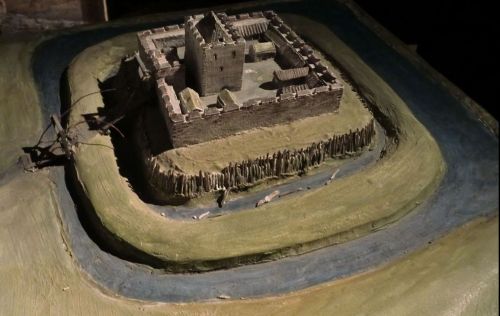
Model in Västergötlands Museum of the medieval castle Gälakvist in Skara. It was also called Skarahus. With its double moat, a 10 meter high artificial hill and ten meter high walls, it must have been a difficult task for an attacker. Photo Dagjoh Wikipedia.
Peace was made in Laholm in Scania in 1278, where Magnus Ladelås escaped having to pay 4000 marks of silver.
However, Erik Klipping had convincingly been demonstrated the disadvantages of being a neighbour of a new united Sweden. During the negotiations in Laholm, he further demanded that Magnus ceded the Götalands to his brother, Valdemar, who of course received Danish support.
However, Valdemar Birgersson was not a man with many talents. Against expectation, Magnus could easily take the Götalands back already i 1279. King Erik did not manage to keep Valdemar Birgersson in place in the same consistent way as the Holstenians kept the Abel lineage in place in Southern Jutland.
Faced with this reality, King Erik decided to create good relations with the newly united Sweden. He changed horse again and supported Magnus Ladelås. The payment for the war aid was further written down to 2000 marks of silver, and Erik's daughter Margrete was betrothed to Magnus' son Birger. In doing so, Valdemar Birgersson's claim for dowry for Sofie was also forgotten and evaporeded.

The peninsula where the ruin of the fortress Axewallahus is. Axevalla was surrounded by water on three sides, and had walls up to 18 meters high, which at the foot were up to 6 meters thick, and were protected by a moat on the side facing land. It has been a very difficult fortress to attack. Photo Dagjoh Wikipedia.
As reported above, Valdemar the Victorious's grandson, Erik Knudsen, got the four southernmost shires in Halland as a fief as the Duchy of South-Halland as part of the charm offensive against the Lande Peace princes in 1284.
That kind of border princes was originally a continuation of the Viking Age frontier earls who had the task of defending the kingdom's borders. But as with the other royal relatives, Erik Knudsen's loyalty to the King and the Fatherland could be in a rather small place. In 1285 he was thus knighted by the Swedish king Magnus - perhaps as a kind of demonstration against Erik Klipping.
In connection with the Hindsgavl Peace in 1295 by Erik Menved, that ended the war with Norway, there is an announcement of a dispute between him and his lord, the king of Denmark.
The Swedish king, Magnus Ladelås, was in 1285 appointed arbitrator in Kalmar in the dispute between Lübeck and Norway - a dispute which also concerned Denmark. He ruled that all seized Lübsk goods should be returned and the Norwegians should provide compensation for conquered German ships. But thereby Denmark's problems with Norwegian attacks on Danish ships and coastal towns became unresolved and only bigger. Perhaps Magnus was inspired by his Holstenin queen.
King Håkon Håkonsson of Norway ended more than 100 years of Norwegian civil war between Birkebeiners and Baglers by marrying the daughter of he Bagler king in 1225 and then defeating the remaining small rebel groups.
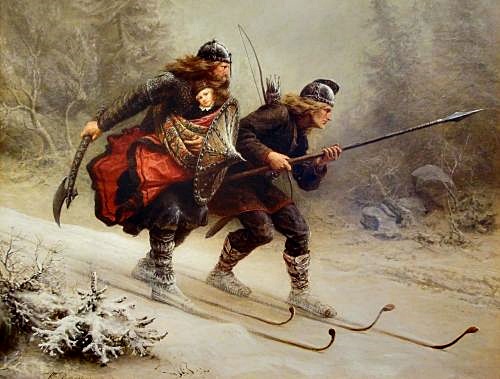
The iconic Norwegian painting by Knud Bergslien from 1869: "The birkebeiners skiing over the mountains with the royal child". Håkon Håkonsson was born in the Bagler area, which was not safe for a little Birkebeiner prince. The painting shows the Birkebeiners, Torstein Skevla and Skjervald Skrukka, who brought the little heir to the throne to Nidaros in 1206. Photo Knud Bergslien Wikipedia.
In 1261, King Håkon proposed on behalf of his son to Erik Ploughpenning's second eldest daughter, Ingeborg, and perhaps received a delaying answer. Margrete Sambiria was not happy about such a connection - as the dowry that it was necessary to settle in connection with such a marriage would increase foreign princes' claims on Danish property and correspondingly reduce the royal income, which was already on its knees due to the church and the royal relatives' extensive and relentless demands for "justice" in the form of estades and fiefs. She had the seventeen-year-old Ingeborg placed in a monastery near Horsens.
But the Norwegians did not lose heart. King Håkon sent seven ships directly to the monastery, and Ingeborg, who was not interested in a life as a nun, hurried to pack her things and boarded one of the ships. She married the king's son, Magnus - who was to be bynamed Lagabøte - in September 1261 and together they had the sons Erik and Håkon, who both became kings.
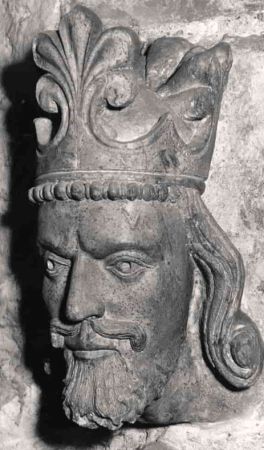
Magnus Lagabøte in Stavanger Cathedral. The byname Lagabøte means the law improver. Photo Thornews.
Ingeborg's father-in-law, Håkon Håkonsson, ruled Norway for 47 years. He died on the Orkney Islands in 1263, defending the islands against attacks from the King of Scotland. Then Magnus Lagabøte became king and Ingeborg queen.
Magnus was a peaceful and conscientious king. He carried out a comprehensive revision of the old laws and in 1274 he issued a unified national law, in 1276 a City Law and in the years 1273-1277 a law for the hird, the kongs sworn men. The National law mentions a problem with abandonned farms and seeks to stimulate new clearances of forrest through tax exemptions,
It was forbidden to sell silver to clergy. This was to prevent the church from sending crusade tithes to the pope. Tax and tithing were often levied in kind, but one could not send grain, butter and wool to the pope as tithing, it had to be exchanged with silver.
When King Magnus Lagabøte died in 1280 after 17 years on the throne, he was succeeded by his eldest son, Erik Priest-hater, as king of Norway.
It is quite certain that Erik as a young man suffered a permanent brain injury after a fall from a horse, which led to a mental disability. Therefore, the widowed queen Ingeborg was effectively his guardian.
In the autumn of 1283 Erik Klipping entered into a separate agreement with Lübeck and on this occasion Denmark joined Lübeck's blockade of Norway, which was based on piracy. A blockade which was maintained in connection with Denmark becoming a member of the Land Peace League in 1284.
Queen Ingeborg thus had two reasons for maintaining a tense relationship with Denmark. One was that Denmark's entry into the Land Peace League made Denmark a participant in this association's blockade of Norway, and the other was that her inheritance from her father, Erik Ploughpenning, had not yet been paid out.
Norway was not able to produce enough food for its own population, and therefore the Lübeck merchants' supplies of grain, flour and malt were vital. Only the merchants, who sold such goods, were allowed to buy butter, skins and beef. This resulted in corporal clashes in Bergen where German merchants' stocks were seized.
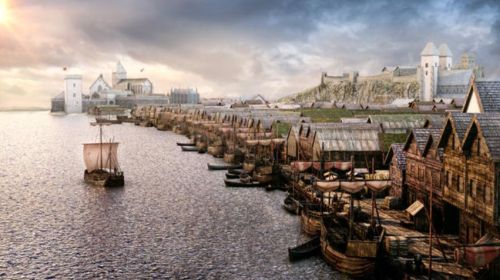
Graphic reconstruction of Bergen around the year 1300. Photo Medieval Research Cluster.
To free themselves from this unwanted mercantile dominance, the Norwegians started an actual pirate war - officially directed against the German cities. The leader of these expeditions was Queen Ingborg's faithful follower, Alf Erlingsson, also called "Lesser-alf" because of his short stature. He operated mostly in Danish waters, where he plundered everyone he met, whether it was German, Danish, Frisian or Dutch ships, and plundered many Danish islands and in 1285 both the cities Horsens and Kalunborg.
Ryd Monastery Chronicle tells for 1285: "Alf Erlingsøn - Alf the Mild - from Norway was a mighty pirate. He plundered Kalundborg and many islands in Denmark".
After the arbitration of the Swedish king Magnus Birgerson in Kalmar in 1285 between Lübeck and Norway, the Danish problems with the Norwegian piracy and looting remained unresolved, and after Erik Klipping's death they continued well into Erik Menved's reign - even though the Danehof in 1284 had decided that the Eriksdaughters should have their inheritance handed over. However, it was still tricky to make things happen. Only Duke Valdemar gave Ingeborg what he thought she had in South Jutland as inheritance.
Jacob of Halland received his father's fief, North Halland, in 1283. He chose to receive the knighthood of the Norwegian king - probably as a kind of demonstration against his own king, Erik Klipping. Ryd Monastery Chronicle for 1285 wrote: "Count Jacob of Halland was knighted by the King of Norway."
As mentioned, King Erik was the eldest son of Christoffer I and Margrete Sambiria.
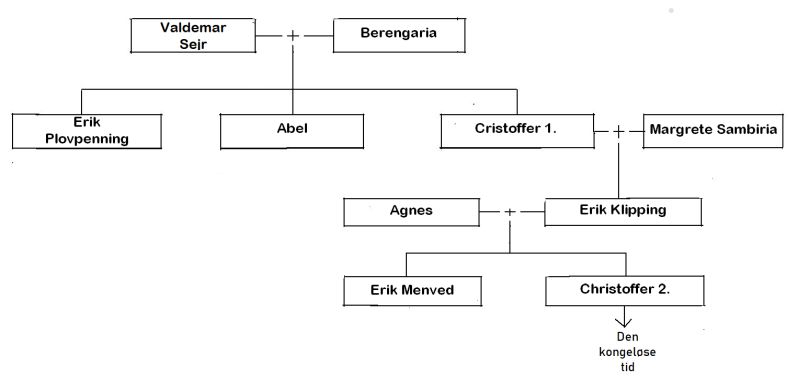
Simplyfied Family tree for the Valdemars from Valdemar the Victorious to Christoffer 2.
Erik Ploughpenning, Abel and Christoffer 1. were sons of Valdemar Sejr and Berengaria and they all became kings, one after the other. Erik Klipping, who suffered death in Finderup Lade, was the son of Christoffer 1. and the famous Margrete Sambiria. His sons with Agnes of Brandenburg were Erik Menved and Christoffer 2. who both became kings. Of these seven kings, only three died a natural death.
But Margrete and Christoffer had another son, as Pope Urban 4. could accuse Peder Bang of having banned a Junker Valdemar together with the young Erik Klipping. This Valdemar is also mentioned in the so-called Ringsted plaque of funerals in Ringsted Cathedral. It states his day of death as December 21, but not his year of death.
But the plaque says that this Valdemar got his grave at the foot of Duke Knud Valdemarsen's grave, so he must have died after this uncle died on 1. of October 1260, but apparently before Margrete in 1263 sent a letter to the pope requesting his acceptance of female succession, stating that the king had no brothers.
Erik's sister Mechtilde married Margrave Albrecht of Brandenburg. Which further documents Denmark's close connection with Brandenburg.
In addition, another sister is mentioned, as Erik Klipping in his letters of privilege to Kiel and Hamburg on 20 July 1283 mentions Count Johan 2. of Holsten as his brother-in-law and his wife as his sister. Other sources indicate that her name was Margrete.
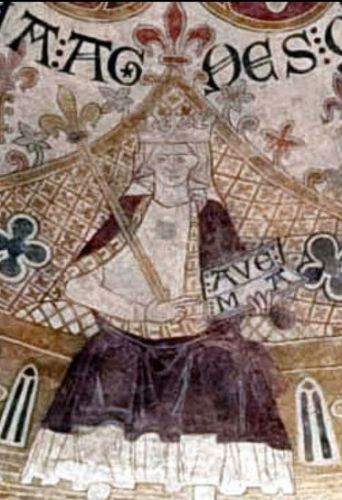
Agnes of Brandenburg with the lily stick, which symbolizes the trinity and the true Catholic faith, on fresco in Skt. Bendts Church in Ringsted. The picture is painted in her lifetime and in all likelihood has portrait likeness. Foto Enstropia Wikipedia.
The young Erik Klipping married Agnes of Brandenburg, who was the daughter of Margrave Johan 1. of Brandenburg and Jutta of Sachen.
Jutta had been married to Erik Ploughpenning, but after his death by murder in a boat on Slien, she remarried. Agnes was thus half-sister to Erik Ploughpenning's four daughters.
Instead of paying dowry to Denmark, her father, the Margrave, had to forgive a debt to Duke Erik Abelsen of Southern Jutland, who had taken the young Erik Klipping and his mother prisoner in the battle at Lohede in 1261 and therefore believed he was entitled to this benefit.
The wedding took place in Slesvig Cathedral in 1273. Erik was then 24 years old and by all accounts a handsome and stately man, and Agnes was 16 years old and reportedly very beautiful.
Agnes and Erik had five children together. Three sons and two daughters.
The sons Erik Menved and Christoffer 2. both became kings of Denmark. The third son, Valdemar Eriksen, died in 1304.
The eldest daughter, Margrete, was married in Sweden to King Magnus Ladelås' son, Birger Magnusson, as described above. Birger Magnusson became king of Sweden and she became queen.
Sweden had similar problems as Denmark with royal brothers, who were appointed dukes in different border areas and from there challenged their brother, the king.
But King Birger had a more radical solution to the problem. In 1317 he captured his brothers in Nyköping, where he put them in a prison tower, where they starved to death, the so-called "Nyköping Banquet".
Birger and Margrete traveled to Denmark in 1318. He died three years later and she died in 1341. They are buried in St. Bendt's Church in Ringsted.
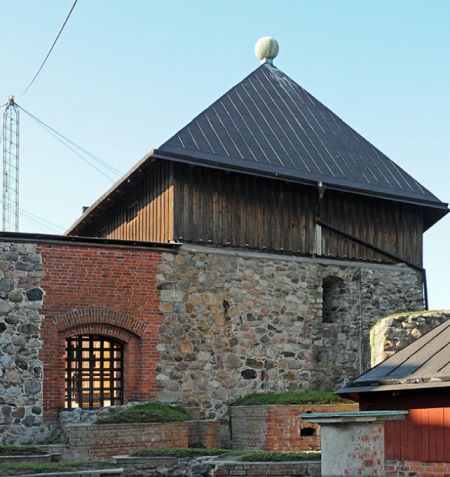
The prison tower in Nyköpinghus where the "Nyköping Banquet" took place in 1317. Sophie's treacherous fiance, Duke Erik Magnussen, was one of the unfortunate participants in the banquet. Photo TS Eriksson Wikipedia.
Erik Klipping's and Agnes' youngest daughter, Richiza, is interesting because she became the tip-tip grandmother of Christian 1. and thus the ancestor of all the Danish kings of the Oldenburg royal dynasty.
Already as a child she was sent to Bad Doberan in Mecklenburg to be brought up in the convent there. She married Prince Nicolaus of Werle. In 1308, her husband founded Masses for her in Güstrow, indicating that she was dead. She had a son named Johan and a daughter, Sophie.
In 1310, Erik Menved succeeded in getting the young Sophie betrothed to the Swedish duke, Erik Magnussen. But he failed in his promise in favor of the Norwegian king's daughter, Ingeborg, and Sophie was sent home from Sweden. Shortly after this episode, she married Count Gerhard of Holsten and thus became the tip-grandmother of Christian 1. and thus the ancestor of the Oldenburg royal dynasty.
Sct. Cecilie night 1286, 22 of november, King Erik Klipping was murdered on his bed in a barn near Finderup southwest of Viborg.
The contemporary gift book in Lund says: "In the year of the lord 1286, King Erik, son of Christoffer, blessed memory, for the daggers of the wicked in Sct. Cecilie night, murdered on the cruelest of his men in his own bed. His soul may rest in eternal peace."
Ryd Monastory Chronicle for 1286 says: "King Erik Christoffersen was murdered in Finderup near Viborg in North Jutland by those he considered his most trusted friends." and "Furthermore, Duke Valdemar was released from prison." From other sources it is clear that Duke Valdemar was released about six months before King Erik was assassinated.
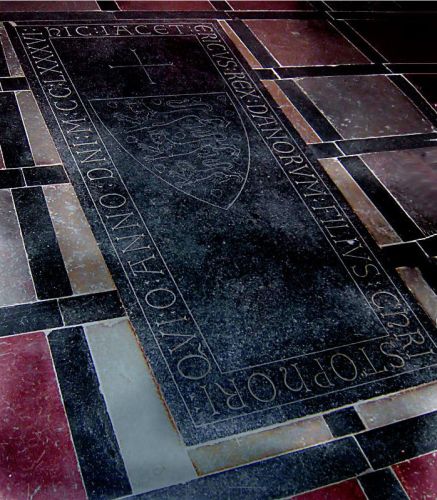
Erik Klipping's grave in front of the altar in Viborg Cathedral. Following the old custom that kings who died an unnatural death should be buried where they fell, Erik Klipping was buried in Viborg Cathedral even though he himself had decided that he should be buried in Graybrothers Church in Odense. In 1708 the tomb was moved and on that occasion a number of smaller triangular and round holes were found in his skull, which indicates that the assailants not only made use of stabbing weapons but also crossbows or similar weapons. Foto Grundejerforeningen Taarnborg.
The Swedish Skäninge Annals from the beginning of the 1300's tell that King Erik was hunting and spent the night in a barn, when seven men broke in through the open door, turned off the lights and murdered the king: "In the same year, Denmark's King Erik Christoffersen was fraudulently murdered when he visited a city for the sake of hunting. He had rested in a barn with an open door when seven men forced their way in and put out the light the candle and murdered the king"
In the Danish defense in the case that Archbishop Jens Grand brought against King Erik Menved before the Pope's court in Rome 1296-1297 it is said: "When their blinded troop of conspirators had been gathered, the sons of darkness rose in the middle of the night with ferocity against King Erik, the Lord's anointed, and in the most cruel way they killed him with innumerable and gruesome wounds, which he received while lying in his bed." It sounds like it was a very passionate killing, it does not sound like a hired assassin.
Several sources, including Jutland Chronicle, say that Erik got "56 fatal wounds of which no one without one was under the breast."
The many folk songs about the horrific murder are also important sources:
There are so many in Denmark,
who all want to be masters
they ride them to Ribe,
and let them clothes cut.
Now the country is in trouble.
Then they had them clothes cut,
and all like monks;
then they rode them up in land,
their rightful lord to betray.
They rode into the peasants farm
with sharp spears in hand;
all wore the gray caps,
that no man knew them.
Then they entered into the barn,
standing on the threshing floor;
awake then lay the noble lord,
he would not believe it.
They stabbed him through shoulders,
stood out from the left side:
"Now we have done that deed,
all Denmark must suffer the pain."
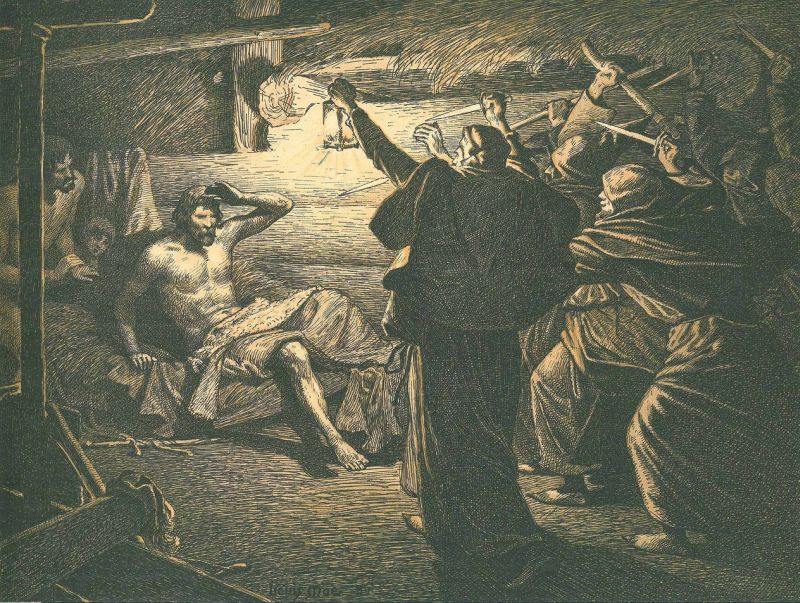
The murder in Finderup Lade. Danmarks Historie i Billeder - 1898.
And in another folk song:
There came riding in that yard,
the monks in cloaks gray.
They did not hesitate long,
they knew where the king lay.
They stabbed him with sword and spear,
they gave him no respite.
There they had weighed the noble lord,
then each went to his horse.
The many concordant details such as, the open door, men in monk cloaks, this that they turned off the light, etc. suggest that there were witnesses. Only the Skäninge Annals is talking about seven perpetrators. The rest of the sources talk about nine men.
The killers could have cleared the table and removed all loose ends, as it is called in modern action movies. But they did not. They let the king's companions live, and for their sake - probably not to be recognized - they were in monk cloaks and also therefore they turned out the light.
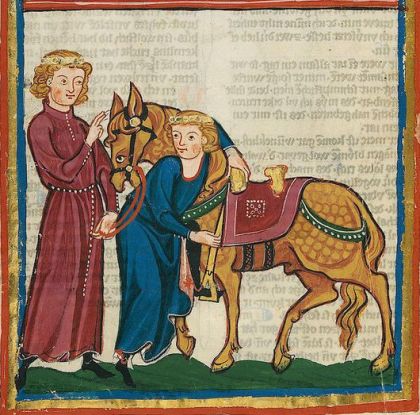
Meister Rumelant in Codex Manesse. Rumelant was the first to mention the 12 "tones" which were standard melodies by Meistersinger. He is known for the song "Daz Gedeones wollenvluis" about God's mysterious love (minne) of the Virgin Mary. He is mentioned in the Codex Manesse and Jenaer Liederbuch. Photo Master of the Codex Manesse Wikipedia.
Queen Agnes made good use of the six months between the murder and the upcoming Danehof the following year. She very quickly brought the famous troubadour, Rumelant von Sachen, to the country, who spread songs and poems, in which it is stated, among other things: ,"See, your king was your servant who gave you power and justice. You have murdered him", and "Faithful Danes, avenge your king - name the murderers and address them for their life."
Rumelant sang about that the killers had done with "own hand", what others had "planned for":
They like to murder with great skill,
the biggest murder we should praise,
in Jutland in the north.
Assassin's murder has been committed,
they could relentlessly awaken their king
on a bed where he slept,
fifty-six deep wounds,
stuck the fighters in him.
It must well be daring fighters,
whose own skills it seemed to be
to do it with their own hands.
Their color and their behviour are gone,
their minds have changed,
those who have planned for this.
One of Rumelant's important points - that the queen had probably instructed him to put forward - was that the murderers should not be allowed to follow their Danish law, which allowed them to swear freedom together with three times twelve accomplices. "No, it must be different!" It was in this way that Abel in his time avoided being convicted, and it must not happen again!
It did not happen either. Erik's murderers were probably convicted under the new laws for crimes against the majesty that the Danehof assembly had passed.
Ryd Monastery Chronicle for 1287 says: "In addition, Count Jacob of Halland and Marsk Stig were banished along with several noble men, and their estates were taken over by the king." and "Furthermore, the king was anointed as king in Lund by Archbishop Johannes on Christmas day. Which king must have been that Erik, who was later bynamed Menved.
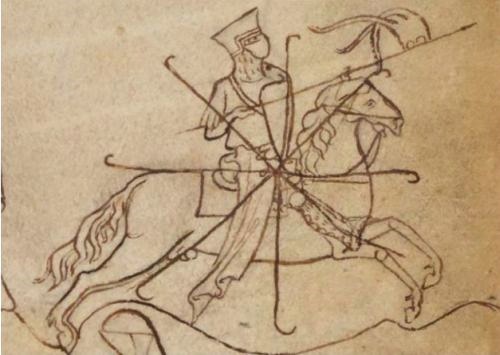
French knight from around 1230. Photo album de dessin et croques af Villard de Honnecourt.
In another edition of Ryd Monastery Chronicle for 1287 it is stated: "At a national meeting in the whitsun same year, Count Jacob, Marsk Stig, Peder Jacobson and several other of the kingdom's mighty men were convicted after everyone's joint judgment to the death for the king's murder and declared outlaws."
In Arild Huitfelt's Chronicle from 1600 it is said: "In the year 1287 to Nyborrig at Whitsun time a common Danehof took place; there came the young king, Queen Agnes, Duke Woldemar, the head of the government, and the bishops and common nobility of the kingdom. They disagreed for a long time beteen themselves, because the mandslaughters were of great nobility, family and friends. Finally, Margrave Ottho, the queen's brother, herutg Witzlaf, the counts of Holsten, who were prescribed, and 27 good men of nobility to search and swear about who his father's manslaughters and killers were. Their testimony was interrogated, and reflection and teaching were read out, whom should have the aforesaid murder committed, and count Jacob, Marsk Stig" - "was sentenced to be the killers and for that matter outlawed to be and their estate to be confiscated" - "And some time later the that verdict over the Outlaws was Confirmation by Keyser Rodolpho Habsburgense. As soon as this happened, the murderers set out to King Erich of Norway."
In connection with the later confirmation of the verdict in 1305, Arild Huitfeldt gives us the names of the nine convicts:
Count Jacob of Northern Halland, who was the son of Niels of Halland, who was the grandson of Valdemar the Victorious. On the mothers' side, he was of the Hvide family. He had allready been re-established in his fief, North Halland in 1283 in connection with the political U-turn at Denmark's accession to the Land Peace league.
Marsk Stig Andersen, who was of an unknown East Jutland family. He married into the Hvide lineage. He led the army that Erik Klipping sent to Sweden in 1275 to help Birger Jarl's sons, Magnus and Erik, to power. For his achievements in Sweden he was appointed marsk.
Knight Peder Jacobsen, who was bailiff, that is the king's representative on the island of Fyn. In the cardinals' final report in 1296, it is mentioned that he was of the Hvide lineage.
Knight Peder Porse, who in all probability was a nobleman from Halland. He later served under the Swedish Duke Erik in Østergötland and after some time moved back to Denmark.
Knight Niels Hallandsfar, who is believed to be another Halland nobleman, a relative of Peder Porse.
Knight Niels Knudsen, who is believed by some to have been one of Duke Valdemar's knights.
Armsman Rane Jonsen from Sjælland, who was the king's chamberlain, which means responsible for the kingdom's finances. He was of the Hvide lineage.
Armsman Aage Kakke from Sjælland, who is believed to have been a relative of Rane Jonsen.
Armsman Arvid Bentsen, who was the only one convicted of physically committing the murder himself. That was probably why the Norwegian king refused to receive him.
In the cardinal auditors' final report concerning the case, that Archbishop Jens Grand brought against Erik Menved at the papal court in 1296, it is mentioned that Count Jacob was considered the leader of the outlaws: "The archbishop replies that it is not true, but the opposite of this answer can be shown in the letters he sent to these kings through the Lund priest Aslo, etc. Among these, a letter was even sent from the archbishop specifically to Count Jacob, who was the main man behind the king's father's killers."
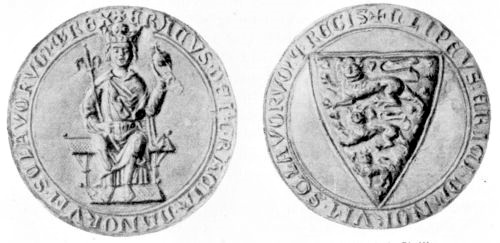
Erik Klipping's seal. He sits with the lily stick, which symbolizes the trinity and thus the proper Catholic faith. He is clean shaven. The back of the coin shows the three Danish lions, which symbolize the three main parts of the kingdom. Photo Karl Georg Jensen Wikipedia.
The same report also mentions that many of the outlaws were of the Hvide lineage, as Jens Grand himself was: "This archbishop's relatives - namely Count Jacob, Marsk Stig, Peder Jacobsen, Rane Jonsen and several others of their family, and they were noble of descent but unfortunate and unlucky in deed. The king made them rich above all the kingdoms faithful supporters of kingship and kingdom - and he appointed them as masters over all the revenue and income of the land, so that he reserved only the name of king for himself."
A verdict of quilty was handed down in the case at Danehof in Nyborg in May 1287 by a "Worthældnævn" - a word-keeping board - consisting of three times twelve men - almost unanimously - which is quite convincing. Further, the judgment was affirmed by the archbishop and all the bishops and later by the German emperor Rudolf of Habsburg.
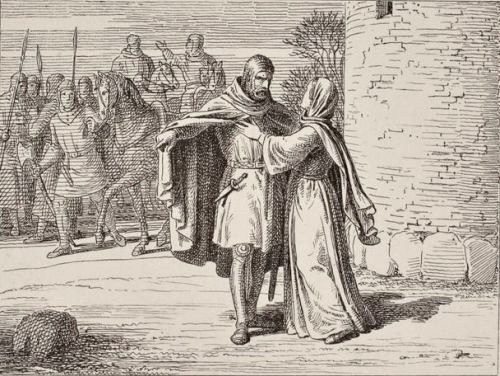
Constantin Hansen's illustration in Svend Grundtvig "Marsk Stig: Danish folk song from 13. century, 1861. Foto SMK.OPEN.
In the later confirmation of the verdict in 1305, Arild Huitfeldt says that only Arvid Bentsen was convicted of "by his own hand" having carried out the murder itself, while the others were convicted of "counsel, command and action to kill him."
As mentioned above, Count Jacob was the leader of the outlaws, probably because he was of royal descent. But for posterity and in folk songs, Marsk Stig appears as the leader, probably because of his military qualifications, the good story with the king's seduction of his wife, his dramatic pirate raids down in the Danish waters and his very visible possession of the island of Hjelm off Helgenæs in Djursland.
Marsk Stig died a natural death in 1293 in his fortress on Hjelm. Together with many other coastal village churches, Stubberup Church on Hindsholm claims that he is buried there.
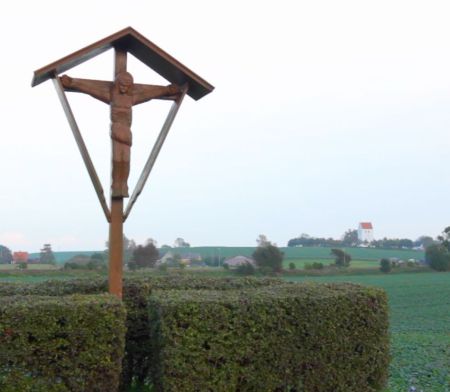
Crucifix at the road to Fyens Hoved with Stubberup Church in the background. As long as anyone can remember there has been a crucifix at the side of the main road leading to Fyens Hoved near Stubberup Church. It is said that it marks where Marsk Stig was carried over the road to his funeral in the church. Photo Martofte BnB.
Peder Jacobsen was the only one of the outlaws who was present when the case was resumed in 1305. Apparently he was particularly eager to be cleared of the charge.
Rane Jonsen was captured during a looting raid to Sjælland, executed and dismembered in Roskilde in 1294. He was present in Finderup Lade and had, according to Jens Grand's testimony, tried to defend the king, however he survived, which in itself was deeply suspicious and certainly disgraceful.
Rolf Krake's household troops had defended their king to last man and last drop of blood. Canute the Holy's hird in Odense and King Nils' men in Slesvig did the same - but not Rane Jonsen in Finderup.
Aage Kakke was killed in 1295 during a visit to Viborg for which he had been promised safe-conduct.
The Skänninge-annals reports that Arvid Bentsen and ten of his men were executed for highway robbery in Halland in 1288. May be one and a half year after the death of Erik Klipping.
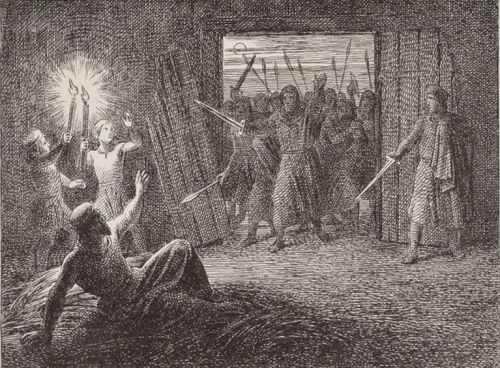
Constantin Hansen's illustration in Svend Grundtvig's "Marsk Stig": Danish folk song from the 13'th century, 1861. Photo SMK.OPEN.
The outlaws all fled to King Erik Priest-hater in Norway, as Norway was not a member of the Land Peace League and therefore did not have a duty to declare outlaws from other countries as outlaws in Norway as well. King Erik adopted the outlaws as his own men and took them, their families and all their estates under his peace and protection and promised them assistance. However, he refused to accept Arvid Bentsen.
During their exile, the outlaws succeeded in convincing both the King of Norway and the King of Sweden of their innocence and also persuaded them to recommend Erik Menved to resume the case.
None of the convicts had any obvious motive for the murder, because since Erik's political U-turn in 1283-84 they had had the power in the kingdom. As stated in the report of the papal auditors: "The king made them rich above all the king's faithful supporters of the kingdom - and he installed them as masters over all the income and earnings of the land, so that he reserved for himself only the royal name."
The historian Troels Brandt points out that even though the outlaws were convinced of their innocence, they did not have the faintest idea who then was responsible for the murder of the king.
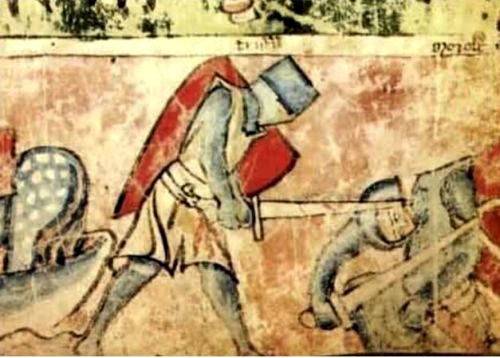
German knight in Tristan Manuscript from around 1225-1250. Photo Bayeriche Staatsbibliothek, München Deutchland
They had not imagined that this could happen. They had been taken completely with their pants down. For years they had probably promoted themselves with small stupid demonstrations such as being knighted by the Norwegian or Swedish king instead of their own king and the like. On festive occasions, they had probably not spared derogatory remarks about King Erik, probably in a similar way as mature Danish men for several years have behaved by demeaning a now former American president.
They must have felt completely safe, as they belonged to noble, rich and numerous families, who could easily put up with the 24 knights that was needed to be acquitted by the "double twelfth oath", if anything went wrong. As Abel did in 1250.
Therefore, when the king was assassinated, they appeared to the whole country as the king's most angry opponents and the most likely perpetrators and with Arvid Bentsen and his highway robbers as their tool.
But there are many indications that it was a committed emotional murder more amateurish than we think.
It is told in the Skänninge annals that Arvid Bentsen and ten of his men were executed for highway robbery in Halland in 1288. Which sounds strange, because if Arvid and his men were professionals, hired to carry out the murder, then they must have received a nice sum of money for the job - it may not have been cheap to murder a king. But why did they then still wander about as shabby highway robbers a little more than a year after the murder? They could have retired, bought a homestead for the money or the like.
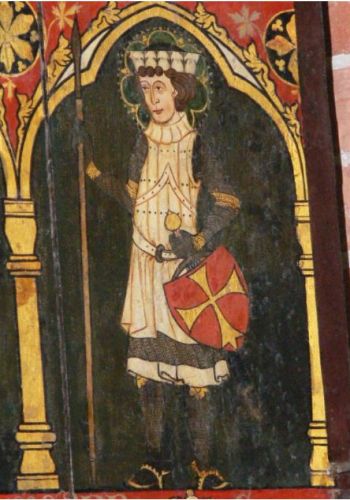
Painting with knight on relic box from around 1325 in Løgumkloster Church. Photo Korsfarerne.dk
Moreover, King Erik was inflicted innumerable wounds, as it is said "and most cruelly they killed him with innumerable and gruesome wounds, which he received while lying in his bed," and it indicates that it was not a hired assassination but a passionate murder, committed by men, who had personal, religious or other emotional reasons to hate King Erik deeply.
Arvid Bentsen and his men probably had no kind of emotional relationship with the king. They did it for the money - if it was them. One may think that they would have carried out the killing professionally and simply given the king the wounds which ensured that he was completely dead.
Moreover, the handed down descriptions that the killers were dressed in monk cloaks, that they put out the lights and of Rane Jonsen's vain struggle indicate that there were surviving witnesses. But one must believe that real professionel assassins - in the situation that they had full control over the events in the barn - would not have put themselves in danger by leaving witnesses alive.
The historian Palle Lauring is surprised that King Erik sought night shelter in a barn at Finderup and did not ride on to Finderup vicarage, which was quite close by and where he could have spent the night much more comfortably.
But Erik may have had his reasons. Priests and other clergy in the Diocese of Viborg belonged to Bishop Peder of Viborg, who was installed in the office by Jacob Erlandsen in 1267, so to speak, by force, as Peder had his opponent, Provost Troels, thrown into prison.
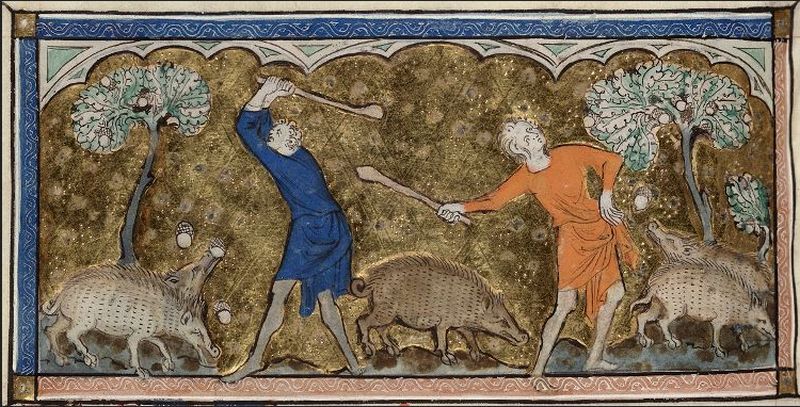
Queen Mary's Psalms from about 1310–1320 - Harvesting acorns to feed pigs. Photo Queen Mary Master Wikipedia.
There is thus reason to believe that Bishop Peder ruled Viborg diocese rigidly with an iron fist and he was an ardent supporter of Archbishop Jacob Erlandsen, whom, however, Erik or his mother had let kill in 1274. Which makes it probable that Peder and the followers, that he most likely have surrounded himself with, nurtured a desire to avenge their idol.
The folk songs say that the assailants were wearing gray monk cloaks:
There came riding in that yard,
the monks in cloaks gray.
Bishop Peder and his followers were locals and they may not have had a hard time following the royal hunting party and registering where they were staying overnight. Nor would it have been a problem for them to procure a number of monk cloaks.
The whole theatrical set-up of the murder evokes imaginations of God's righteous hand against the presumed enemy of God, and this may precisely have been the purpose of the monk cloaks and the masking as well as the fact that they let the witnesses live - as it precisely was a purpose that the details of the event should be known.
Besides Rumelant's and Jutland Chronicle's "56 fatal wounds of which no one without one was under the breast", the description in Erik Menved's defense in Rome "innumerable and gruesome wounds" and the triangular and round holes found in Erik's skull in modern time, indicate clearly that the perpetrators were ruthless fanatics motivated by intense hatred - very likely towards "this world's crazy tyrant".
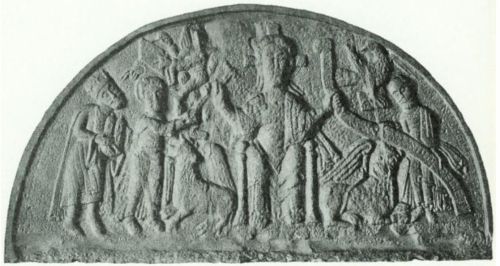
The semicircular so-called tympanom over the door in St. Peter's Portal in Slesvig Cathedral from around 1180. The figures depict the handing over of God's key to Sct. Peter as it is written in the Gospel of Matthew: "And I will give unto thee the keys of the heavens, and whatsoever thou shalt bind on earth shall be bound in the heavens, and whatsoever thou shalt loose on earth shall be loosed in the heavens."
In the center of the picture is the enthroned Christ with the cross halo, surrounded by the four evangelist symbols. On his left is the apostle Paul, who is presented with a speech band (a medieval speech bubble). Unfortunately, part of the band's Latin inscription has disappeared due to weathering. However, the first part of it is reconstructed and unambiguously translated as follows: "Drive me out of this world's crazy tyrant and call those people back." On the right side of Christ is the apostle Peter, who is handed the keys.
The expression "this world's crazy tyrant" must certainly be aimed at the worldly rulers, namely the kings - directly or indirectly. It illustrates the enmity and resentment against the king that large parts of the church probably nurtured throughout the Catholic period - and the idea that the spiritual sword should take precedence over the secular sword.
All monasteries and churches were self-supplementing. They could promote and exalt them of their own, which they preferred, and humble others. Actually very similar to the modern universities, which are also self-supplementing and self-governing and live on well-established paymrnts that come from society as a whole.
Archbishops were elected by the cathedral's priests, which was the organized clergy at the cathedral. When the priests could choose such fanatics as Jacob Erlandsen and later Jens Grand, it must be because these reflected their own attitudes and dreams.
Photo Grænseforeningen.
Seen with modern eyes, the most weighty proof that the outlaws were the culprits is that they were actually convicted by an overwhelming majority of a "Worthældnævn", a word-keeping board, of 36 members. We conclude that they were contemporaries and must have known best.
But at the same time, it is striking that the outlaws lacked motive. Jacob of Halland had already regained his fief. Marsk Stig was allowed to keep his office even though he was critical of the king. They had got their policy through, as King Erik had signed a treaty which bound him to their conditions and political line. What kind of mental confusion made them kill the king?
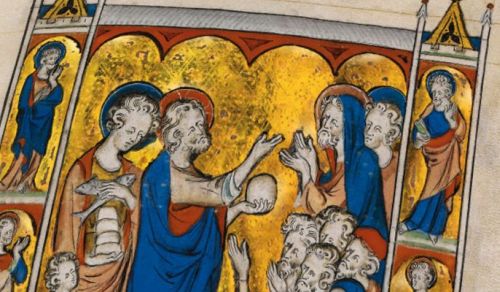
Illustration in Queen Mary's Psalter from around 1300. Photo The Queen Mary Psalter.
In the king's defense in the case between Jens Grand and Erik Menved, it is precisely stated that Erik Klipping had given the conspirators everything they wanted: "Yes, this King Erik Kristoffersen raised some of this archbishop's and bishop's relatives as his children, namely Count Jakob, Marsk Stig, Peder Jakobsen, Rane Jonsen and several others - He made them rich instead of all the kingdom's faithful supporters, he had them in his house, he placed them as fathers over the kingdom, and he appointed them as masters over all the revenue and income of the kingdom, so that he alone reserved the royal name."
Many modern historians have instead focused on Duke Valdemar Eriksen of "Jutland" (which is Southern Jutland).
He had demonstrated his ardent ambitions by asking the archbishop in a letter to address the pope with his demand to become king of Denmark instead of Erik Klipping. He had attacked the royal possession of Als with military forces and thereby broken his fidelity oath. He had been thrown into prison and humiliatingly forced to make vows of eternal and unconditional allegiance to King Erik, which was the complete opposite of the ambitions he had demonstrated so many times.
And last but not least, he was the one, who got the biggest benefit from the murder. Ribe yearbook for 1287 writes: "At a national meeting, Duke Valdemar got everything his father had had before him". In addition, widow Queen Agnes gave him power throughout the kingdom by making him guardian of her young son Erik - who would later be bynamed Menved.
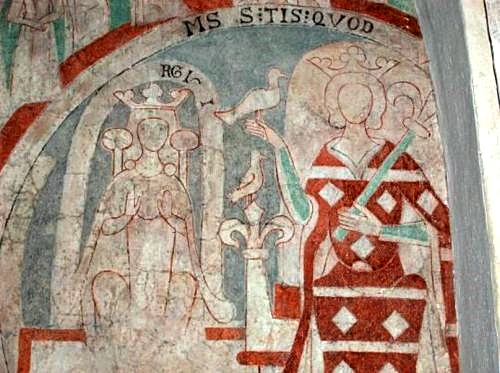
King and queen on fresco in Keldby Church on the island of Møn from around 1325. Photo kalkmalerier.dk.
Some suspected Duke Valdemar already at that time. Jutland Chronicle for 1286 says: "In his 24th year of reign, Duke Erik's son Valdemar was made Duke of Jutland. In the second year of his dukedom he was taken prisoner by the king and thrown into prison. But the following year, when he had been released by the intervention of the princes, he began, together with several of the great men of the kingdom, to conspire about the death of the king. This one was also killed by some whom these had sent, near Viborg, when he slept in his bed in the night of St. Cecilie in the year of the Lord 1286."
Duke Valdemar had the motivation, financial means, ambition and probably also connections that could have made him the real man behind the royal fashion. He had previously on several occasions clearly demonstrated the necessary determination. He had demonstrated that he did not have much trouble breaking his word if he found it advantageous.
But, however, there is another agent who deserves to be brought to light, namely the former drost Peder Nielsen Hoseøl, who was deposed in 1283 in connection with the political reversal in favor of the king's relatives and the "Count Jacob party".
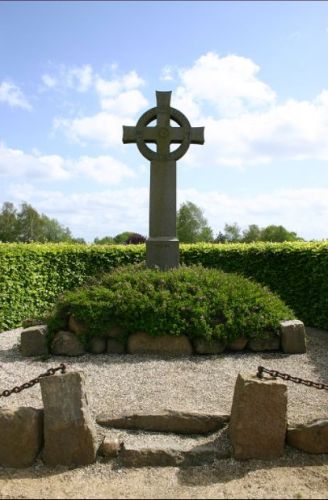
The Finderup Cross, which is a monument in Finderup near Viborg, at the place where King Erik Klipping was murdered on 22 November 1286. The cross was paid for by the poet Thor Lange and was unveiled on the 605. anniversary of the murder on 22 November 1891. Photo Calvin Wikipedia.
In the pope's auditors' final report on Jens Grand's case against Erik Menved, it is stated about the "Count Jacob party" and the king's relatives: The king made them rich above all the kingdoms loyal supporters, and he installed them as masters over all the revenue and income of the land, so that he alone reserved the royal name."
Peder Nielsen Hoseøl was known as a steely and tough man who steadfastly supported the king - or should we believe steadfastly supported Denmark. He was the probable leader of "all the kingships loyal supporters", who had been displaced from power. This probably means good Danish men, who were not affiliated with the "Count Jacob" party, the king's relatives or Duke Valdemar.
Kings are elected for life, and they are kings until they die. In former times if the people wanted to get rid of their king, they could not just depose him; they had to make sure he died. The Goths in Italy used this solution several times, and many other peoples have done so throughout history. The Danes did it against Harald Bluetooth and Canute the Holy and maybe they did it against Erik Klipping as well.
The kingships loyal supporters and good Danish men may had looked on helplessly while Erik Klipping had thrown away all that Erik Ploughpenning, Christoffer and Margrete Sambiria had fought for in regaining the principalities that Valdemar the Victorious had so frivolously separated from the kingdom in favor of his many sons. They witnessed that King Erik did not manage to keep Sweden divided. They saw the handing over the country's government and administration of the royal revenue to the king's relatives and the ambitious and self-conscious "Count Jacob party", who had most likely acquired their wealth at the expense of many lesser nobles. They had very lately seen that the king had the opportunity to get rid of Duke Valdemar and reunite southern Jutland with the kingdom, but he did not have the determination to do it. They might have learned that King Erik had withdrawn from the daily decissions in favor of a more hedonistic way of life with hunting, knight tournaments and parties.
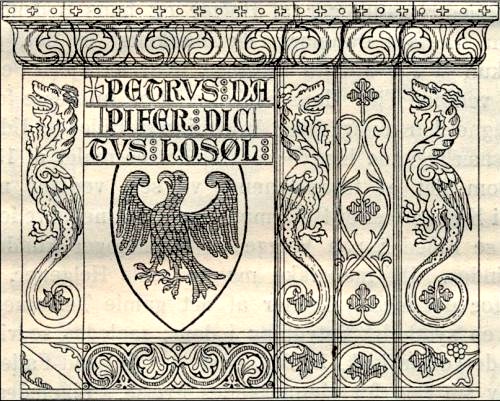
Peder Nielsen Hoseøl was himself a Hvide. The picture shows his coat of arms in the Hvide lineage's large monument´in Sorø Monastery Church. "Petrus Dapifer dictus Hosøl" means "Drost Peder, called Hoseøl", that is stocking strap. Photo: "De gamle Kalkmalerier i vore Kirker" by J. Magnus-Petersen, 1900.
Peder Nielsen Hoseøl, together with a party of good Danish men, may have implemented the legislation on crimes aganst majesty at the Danhoffet, which disregarded the provisions of the old laws on the "double twelfth oath" when it came to crimes against the king.
With probable knowledge of the court's plans for hunts and tournaments, they were able to plan and carry out the theatrical murder in Finderup, which has confused everyone for hundreds of years.
Then they could accuse the leading members of the "Count Jacob party" and their accomplices - who for decades had promoted themselves with small demonstrations and most likely derogatory remarks about the king - of having carried out the assassination, and getting them convicted, without they were given the opportunity to swear themselves free.
In this way, they would have killed two birds with one stone. They would have gotten rid of a - in their opinion - incompetent king and their political opponents at the same time.
Such a theory explains the king's many wounds - because everyone should take part in such a killing, so no one should have the opportunity later to say that it was the others who did it. It explains why they let the witnesses live - because they were honest men, who did not want to kill innocent people. It explains the many remarks about that the king died because of his lack of chastity - because they believed that he had failed in his duties as a king in favor of a hedonistic way of life.
But it is not entirely satisfactory that honest men should have gone totally mad and maltreated the the king's dead body as it happened.
| Til start |